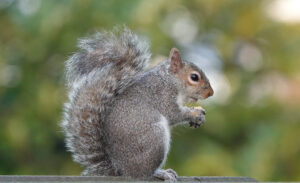
Keeping little critters out of birdfeeders
If you ever put up a birdfeeder, you might find that soon enough you are getting more than just birds. Squirrels are very good at

If you ever put up a birdfeeder, you might find that soon enough you are getting more than just birds. Squirrels are very good at
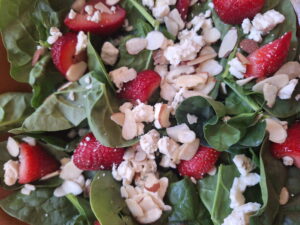
This fresh salad is the perfect light lunch on a nice spring day. Pair it with grilled chicken or shrimp and a loaf of crusty

Dress up a plain flower pot with an easy pour-paint method. The most time-consuming part is waiting for the paint to dry. This is a
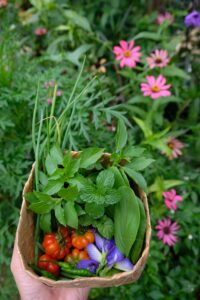
The task of creating a dedicated vegetable garden can feel overwhelming—carving out a large chunk of your yard to create the perfect growing space isn’t
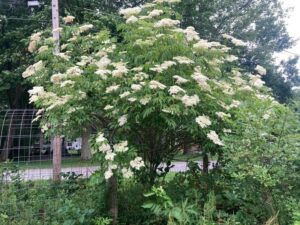
I think native bushes (aka shrubs) are the most underrated of landscaping possibilities. Because of their size, they are relatively easy to handle for planting

The 100-year-old maple that once stood in my front yard had to be removed recently. It just hurts my heart to think about it, but

THURSDAY MARCH 13, 2025 11 am: It’s a Jungle Out There–Floral Design— Dorothy Julius, Along Gardens Path Noon: Revisiting the Greats … Perennial Plant of

Looking for a new spring carrot recipe? Look no further! Our brown sugar and bourbon glazed carrots are a perfect side dish for early spring.
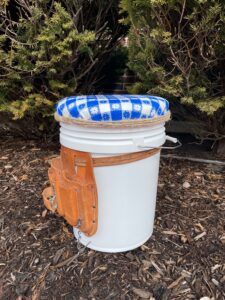
Want to garden comfortably? This padded bucket seat serves double duty as tool storage and a seat for gardening. We used materials we had on

As the days get longer and the temperatures begin to increase, our resident birds who stayed all winter will start to fill the air with
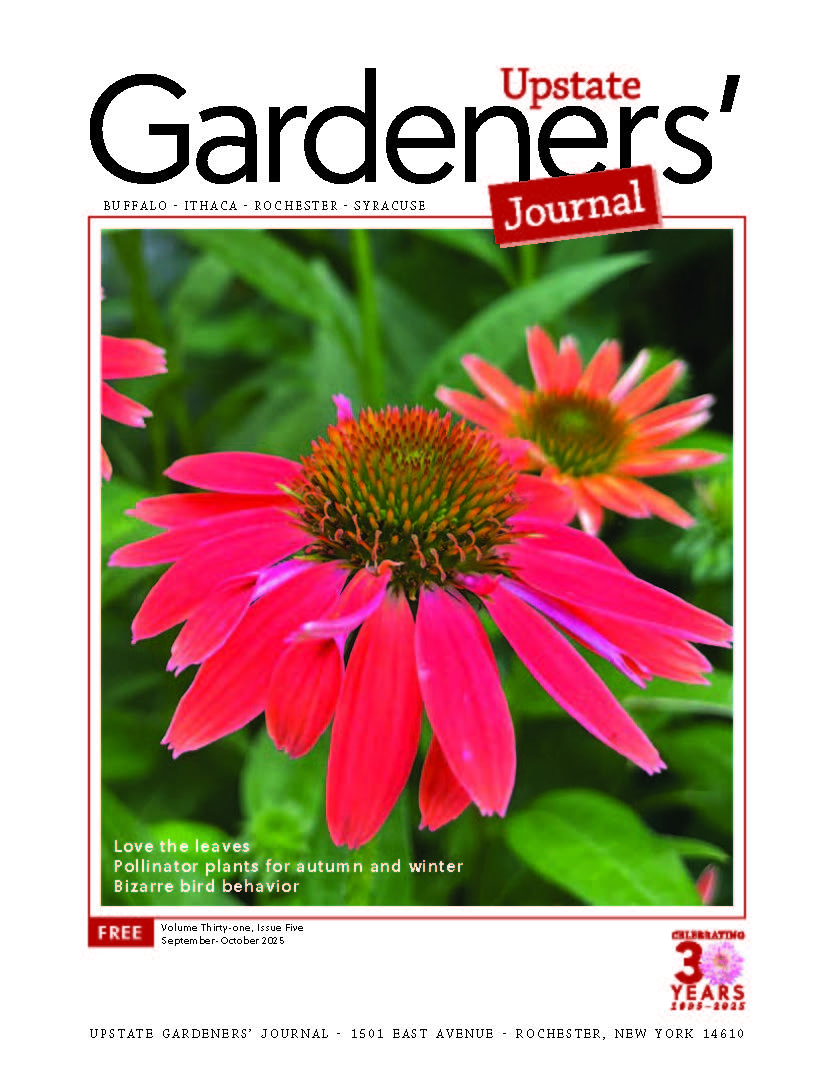
BUFFALO
REGULAR CLUB MEETINGS
African Violet & Gesneriad Society of WNY meets the third Tuesday of the month, September–August, at 7 p.m., Greenfield Health & Rehab Facility, 5949 Broadway, Lancaster. [email protected].
Alden Garden Club meets the second Wednesday of the month (except July and August) at 7 p.m., Alden Community Center, West Main St., Alden. New members and guests welcome. Plant sale each May. 716-937-7924.
Amana Garden Club meets the second Wednesday of the month (except January) at Ebenezer United Church of Christ, 630 Main St., West Seneca. Visitors welcome. 716-844-8543, [email protected].
Amherst Garden Club meets the fourth Wednesday of the month (except December, March, July, and August) at 10 a.m., St. John’s Lutheran Church, Main St., Williamsville. New members and guests welcome. 716-836-5397.
Bowmansville Garden Club meets the first Monday of the month (except June, July, August, and December) at 7 p.m., Bowmansville Fire Hall, 36 Main St., Bowmansville. New members and guests welcome. For more information, 716-361-8325.
Buffalo Area Daylily Society. East Aurora Senior Center, 101 King St., East Aurora. The society is a friendly group who get together to enjoy daylilies. Plant Sales in August. Open gardens, June–August. Facebook.
Buffalo Bonsai Society meets every second Saturday at 1 p.m. at ECC North Campus, STEM Bldg., 6205 Main St., Williamsville, NY 14221. Picnic/Auction; 9/14, (Rochester, NY) Penjing Bonsai; 10/12, Mark Arpag; 11/9, Suiseki with Sean Smith. buffalobonsaisociety.com.
East Aurora Garden Club meets at noon on the second Monday of each month, except January. The clubs meets at Nativity Lutheran Church, 970 E. Main St., East Aurora, NY (just west of the 400 Expressway exit). The club’s objective is to stimulate, create interest, and promote education on horticulture, the art of gardening, flower arranging, and environmental conservation; and to promote the beautification of surrounding areas. For more information about the club or membership call 716- 912-1589.
Federated Garden Clubs NYS–District 8. Nancy Kalieta is the director; [email protected]. gardenclubsofwny.com.
Forest Stream Garden Club meets the third Thursday of the month (September–May) at 7 p.m., Presbyterian Village, 214 Village Park Dr., Williamsville and other locations. Summer garden teas and tours available. Ongoing projects include beautification of the Williamsville Meeting House, garden therapy at a local nursing home, youth gardening, and Victorian Christmas decorating. [email protected].
Friends of Kenan Herb Club meets the third Monday of the month at 2 p.m. at the Taylor Theater. New members are always welcome. kenancenter.org/herb-club.
Garden Club of the Tonawanda meets the third Thursday of the month at 6:30 p.m., Tonawanda City Hall, Community Room. Facebook.
Garden Friends of Clarence meets the second Wednesday of the month at 7 p.m., September– June, Town Park Clubhouse, 10405 Main St., Clarence. [email protected].
Gardens Buffalo Niagara open gardens on Thursdays and Fridays in July starts Thursday, July 11. Explore the beauty of gardens spread out in Erie and Niagara counties. Visit gardensbuffaloniagara.com/ open-gardens-buffalo for more details and location information.
Hamburg Garden Club meets the second Wednesday of each month (except July and August) at 10 a.m. at the VFW Post 1419, 2985 Lakeview Rd, Hamburg, NY. Events include a June plant sale and July and August field trips. New members and guests are welcome. Contact [email protected].
Kenmore Garden Club meets the second Tuesday of the month (except July, August, and December) at 10 a.m., Kenmore United Methodist Church, 32 Landers Rd., Kenmore. Activities include guest speakers, floral designs, and community service. New members and guests are welcome. [email protected].
Ken-Sheriton Garden Club meets the second Tuesday of the month (except January) at 7 p.m., St. Mark’s Lutheran Church, 576 Delaware Rd. Kenmore. Monthly programs, artistic design, and horticulture displays. New members and guests welcome. 716- 833-8799, [email protected].
Lancaster Garden Club meets the second Wednesday of the month (except January, July, and August) at 7 p.m., St. John Lutheran Church, 55 Pleasant Ave., Lancaster. All are welcome. Facebook.
Lewiston Garden Club meets the fourth Monday of the month. See website for meeting information, lewistongardenfest.com/garden-club.html or contact at PO Box 32, Lewiston, NY 14092.
Niagara Frontier Botanical Society meets the second Tuesday of the month September through May at 7:30 p.m. (except April) at the Harlem Rd. Community Center, 4255 Harlem Rd., Amherst. Entrance is on the north side of the building. Meetings are open to the public.
Niagara Frontier Orchid Society (NFOS) meets the first Tuesday following the first Sunday (dates sometimes vary due to holidays, etc.), September– June, Botanical Gardens, 2655 South Park Ave., Buffalo. niagarafrontierorchids.org.
Orchard Park Garden Club meets the first Thursday of the month (except July and December) at 11:30 a.m. at St. John’s Lutheran Church, 4536 South Buffalo St., Orchard Park. Contact Diana Szczepanski at 716- 674-8970 for membership information. Guests are always welcome.
Ransomville Garden Club meets the third Wednesday or Saturday of the month at 5:45 p.m., Ransomville Community Library, 3733 Ransomville Rd., Ransomville. Meetings are open to all. Activities include community gardening projects, educational presentations, and June plant sale. bbonnie2313@ gmail.com.
Silver Creek-Hanover Garden Club meets the second Saturday of the month at 11 a.m., Silver Creek Senior Center, 1823 Lake Rd. (Rte. 5), Silver Creek. [email protected]
South Towns Gardeners meets the second Friday of the month (except January) at 9:30 a.m., West Seneca Senior Center. New members welcome.
Springville Concord Garden Club meets the second Monday of the month at 1:30 p.m. at the Concord Senior Center, 40 Commerce Dr., Springville, NY 14141. Meetings feature guest speakers on a variety of gardening and related topics. Annual July Garden Walk. Guests are welcome.
Town and Country Garden Club of LeRoy meets the second Wednesday of the month (except February) at 6:30 p.m., First Presbyterian Church, 7 Clay St., LeRoy 14482. Prospective members and guests are welcome. Contact: [email protected]. Facebook: facebook.com/GardenClubLeRoyNY.
Town and Country Garden Club of Williamsville generally meets the second Thursday of the month from 2–4 p.m. at the Ransom Oaks Community Club House, 101 Ransom Oaks Dr., East Amherst. Some meetings are held off site for garden tours and special events. The club maintains a garden at the Clearfield Library, 770 Hopkins Rd. Membership brochures with program information are available in the library. For information, contact [email protected].
Tropical Fish Society of Erie County meets the third Tuesday of the month at 7:30 p.m., Lake Erie Italian Club, 3200 South Park Ave., Lackawanna, NY 14218. tropical-fish-club-of-erie-county.com
Western New York Herb Study Group meets the second Wednesday of the month at 7 p.m., Buffalo and Erie County Botanical Gardens, 2655 South Park Ave., Buffalo. Facebook.
Western New York Honey Producers, Inc. Cornell Cooperative Extension of Erie County, 21 South Grove St., East Aurora. wnyhpa.org.
Western New York Hosta Society. The WNYHS was formed to encourage members to appreciate hostas and to provide them with access to quality new varieties. The group meets three times a year at the East Aurora Senior Center, 101 King St., East Aurora NY 14052. wnyhosta.com.
Western New York Hosta Society Breakfast Meetings are friendly get-togethers the first Saturday (winter months only) at 10 a.m., Forestview Restaurant, Depew, wnyhosta.com.
Western New York Iris Society meets at the Julia B Reinstein Library, 1030 Losson Rd., Cheektowaga, NY at 1:30 p.m. on the first Sunday of each month.
Western New York Rose Society meets the third Wednesday of each month at 7 p.m. St. Stephens-Bethlehem United Church of Christ, 750 Wehrle Dr., Williamsville. Check the Facebook page or website for meeting content, wnyrosesociety.net.
Youngstown Garden Club meets the second Wednesday of every month at 7 p.m., First Presbyterian Church, 100 Church St., Youngstown. Facebook.
FREQUENT HOSTS
BECBG: Buffalo & Erie County Botanical Gardens, 2655 South Park Ave., Buffalo, NY 14218. 716/827-1584; buffalogardens.com.
REIN: Reinstein Woods Nature Preserve, 93 Honorine Drive, Depew, NY 14043. 716-683- 5959; reinsteinwoods.org.
F- Indicates activities especially appropriate for children and families.
CLASSES / EVENTS
September 6: Fall Welcome Walk, 10 a.m. As autumn approaches, enjoy a stroll through the woods to see what animals and plants are up to at this time of year. No registration required. REIN
September 10 & October 8: Senior Stroll, 10 a.m. Seniors can experience nature at their own pace and enjoy a leisurely hour-long guided walk through the woods. For adults only. Registration required; call 716-683-5959. REIN
September 13: Summer's End, Fall's Beginning, 10 a.m. Say goodbye to summer and hello to fall during a walk in the woods. Explore the changes taking place in the forests and ponds as the weather gets colder and the leaves start to turn. Registration required; call 716-683-5959. REIN
F September 16: Turtle Time for Tots, 4:30 p.m. Bring your little ones to explore the amazing world of turtles for an hour, with the help of our three educational turtles. For children ages 4–10. Registration required; call 716-683-5959. REIN
F September 20: 25th Annual Fall Festival, 10 a.m.–4 p.m. Kick off the fall season by spending a day in the woods. Visitors can enjoy hands-on activities, crafts for kids, live animals, food, live music, and more. Call 716-683-5959 or visit reinsteinwoods.org for more information. No registration required. REIN
October 4: Wildlife Day: Birds! This is a day full of walks and talks that celebrate birds. People new to birding can learn the basic birding skills like how to use binoculars, while experienced birders can enjoy a walk or talk with knowledgable folks. All will learn how to help the feathered friends we enjoy at Reinstein Woods and enjoy a free cup of Birds & Beans Coffee. For the schedule and registration, visit reinsteinwoods.org. REIN
October 11: Autumn Walk and Craft, 1:00 p.m. The leaves are changing and the mushrooms are out. This is a guided walk to gather inspiration and recreate the fall colors with an air-dry clay project. For adults only. $5 fee/free for Friends members. Registration required; call 716-683-5959. REIN
F October 11: Linocut Leaves, 1–4 p.m. Create linocut prints using fall foliage. BECBG
October 15: National Mushroom Day Walk, 1:30 p.m. Marvel at mushrooms on this walk through the woods. Registration required; call 716-683-5959. REIN
October 18: Autumn Colors, 10 a.m. Fall foliage is a blaze of color, from vibrant oranges and reds to subtle yellows. Enjoy the beauty of autumn on this guided walk and identify trees in the fall. For adults and children ages ten and older. Registration required; call 716-683-5959. REIN
F October 23: Watercolor Carnivorous Plants, 6–8:30 p.m. Beginner-friendly watercolor workshop. BECBG
SAVE THE DATE...
November 1: Crafting Cordage, 10 a.m. This class teaches students how to identify and harvest dogbane for cordage in a hands-on workshop celebrating Haudenosaunee ethnobotany – the study of how plants have been traditionally used for food, medicine, and other purposes. Registration required; call 716-683-5959. REIN
November 8: Fabulous Fungi, 112 a.m. A mushroom enthusiast leads this beginner-friendly walk and attempt to identify as many mushrooms as possible. For ages 12 and older. Registration required; call 716-683-5959. REIN
November 15: Owls of Reinstein Woods, 7 p.m. Learn about the owls that live in the woods during a nighttime adventure in search of these nocturnal birds. Registration required; call 716-683-5959. REIN
ITHACA
REGULAR CLUB MEETINGS
Adirondack Chapter, North American Rock Garden Society (ACNARGS) Meetings are open to all. Check the current newsletter on the website for meeting location: acnargs.org or Facebook.com/acnargs.
Auraca Herbarists, an herb study group, usually meets the second Tuesday of the month at noon, Cornell Botanic Gardens, Ithaca. Brown bag lunch at noon followed by the program. and herb of the month. Field trips during the growing season. All are welcome. Contact: Pat Curran, [email protected].
Elmira Garden Club meets the first Thursday of the month, April–December, at 6 p.m., 426 Fulton St., Elmira. Annual plant sale, workshops, monthly meetings, local garden tours and community gardening services. Karen Coletta, 607-731-8320, Facebook.
Finger Lakes Native Plant Society meetings are usually on the third Tuesday of the month September to May. They are an organization dedicated to promoting the appreciation of native flora and hold free public field trips, free indoor programs, and provide members a newsletter, seed exchange, native plant sale, and a December celebration of native plants. flnps.org, [email protected].
Windsor NY Garden Group meets the second and fourth Tuesdays of the month at 10 a.m., members’ homes or Windsor Community House, 107 Main St., Windsor. windsorgardengroup.suerambo.com.
ROCHESTER
REGULAR CLUB MEETINGS
7th District Federated Garden Clubs New York State, Inc. meets the first Wednesday of the month. 7thdistrictfgcnys.org.
African Violet and Gesneriad Society of Rochester meets the first Thursday of the month September– November and March–May, 7–9 p.m. at Messiah Lutheran Church, 4301 Mt. Read Blvd., Rochester, NY 14616. December and June meetings are social events TBD location. Contacts: Douglas Burdick, 585-313-8674, [email protected]. Barb Festenstein, 585-461-1673, [email protected].
Bloomfield Garden Club meets the third Thursday of the month at 11:45 a.m., Veterans Park, 6910 Routes 5 & 20, Bloomfield. Visitors and prospective new members welcome. Marlene Moran, 585-924-8035, Facebook.
Bonsai Society of Upstate New York meets the fourth Tuesday of the month at the Brighton Town Park Lodge, Buckland Park, 1341 Westfall Rd., Rochester. 585-334-2595, Facebook, bonsaisocietyofupstateny.org.
Canandaigua Botanical Society meets for in-person botanical events. See website for event schedule. canandaiguabotanicalsociety.blogspot.com
Color Pittsford Green meets on the third Wednesday of the month, 6:45–7:45 p.m. via Zoom. All are welcome. colorpittsfordgreen.org
Conesus Lake Garden Club meets the third Wednesday of the month (April–December) at 7 p.m., Chip Holt Nature Center, Vitale Park, Lakeville. Welcoming new members. Contact Dottie Connelly, 585-703-1748.
Country Gardeners of Webster This club is for those who like to dig in the dirt, smell the roses, learn about the birds and bees, take a walk in the park, eat, drink, and be merry, or live in Webster. They meet the second Monday of the month. Contact Elaine at 585-350-8270 to try this fun-loving club out.
Creative Gardeners of Penfield meets the second Monday of the month (except July and August) at 9:15 a.m., Penfield United Methodist Church, 1795 Baird Rd., Penfield. Visitors welcome. Contact 585- 385-2065 or [email protected] if interested in attending a meeting.
Fairport Garden Club meets the third Thursday evening of the month (except January, February, March, and August) in members’ homes or in the Perinton Ambulance building. Educational topics are presented through speakers, workshops, local tours, and community gardening i.e., Planter at Johanna Perrin School. [email protected], fairportgardenclub.com.
Finger Lakes Daylily Society members garden in west-central NY, covering an area from Batavia to Syracuse and the Southern Tier. Meetings are held in Rochester or the Canandaigua area. There are generally four regular Saturday meetings held in February, March, May, and September. Visitors and prospective new members are welcome to attend. Contact Deb Lawrence for information, [email protected].
Friends of Ellwanger Garden meet all season long on Tuesday mornings. To volunteer at the garden, please contact Cindy Boyer at 585-546-7029, x12 or [email protected].
Garden Club of Brockport meets the second Wednesday of every month at 7 p.m., Jubilee Church, 3565 Lake Rd., Brockport. Visitors can learn gardening tips from knowledgeable speakers, make garden ornaments through hands-on classes, and explore beautiful local gardens. For more info please email [email protected].
Garden Club of Mendon meets the third Tuesday of the month, 10 a.m.–1 p.m., Mendon Community Center, 167 North Main St., Honeoye Falls. Members work on community gardens and gather new ideas in a casual, social environment. 585-624-8182, [email protected].
Garden Path of Penfield meets the third Wednesday of the month, September–May at 7 p.m., Penfield Community Center, 1985 Baird Rd., Penfield. Members enjoy all aspects of gardening, new members welcome. [email protected].
Gates Garden Club meets the second Thursday of the month (except July and August) at 6:30 p.m., Gates Town Annex, 1605 Buffalo Rd., Rochester. New members and guests welcome. 585-247-1248, [email protected].
Genesee Region Orchid Society (GROS) meets the first Monday following the first Sunday of the month. Meetings are held at 6 p.m. at the JCC on Edgewood Dr in Brighton. Please see the website for information, geneseeorchid.org.
Genesee Valley Hosta Society meets the second Thursday of the month, April–October, at Eli Fagan American Legion Post, 260 Middle Rd., Henrietta. 585-889-7678, [email protected], geneseevalleyhosta.com.
Greater Rochester Iris Society (GRIS) is an affiliate of the American Iris Society, meets on a Sunday during the months of March, April, September, and October at 2 p.m., St. John’s Episcopal Church Hall, 11 Episcopal Ave., Honeoye Falls, NY. Public welcome. Plant Sales, guest speakers or location visits, Volunteer Opportunities. Honeoye Falls, NY. 585-266-0302, [email protected].
Greater Rochester Perennial Society (GRPS) meets the first Thursday of each month at 7 p.m., Twelve Corners Presbyterian Church Fellowship Hall, 1200 South Winton Rd., Rochester, except in summer when it tours members’ gardens. Lectures are held virtually, and garden tours are being scheduled. See website or Facebook for updates. cap704@ frontiernet.net, rochesterperennial.com, facebook.com/GreaterRochesterPerennialSociety.
Greater Rochester Rose Society meets the first Tuesday of the month at 7 p.m. on Zoom January, February, and March Email [email protected] for meeting link. Questions: 585-694-8430. Facebook: Greater Rochester Rose Society.
Henrietta Garden Club meets the second Wednesday each month (except May-August and December) at 6:30 p.m. A presenter will speak on a gardening related subject at 7:15 p.m. Guests and nonresidents are welcome. Handicap accessible. Call 585-442-8634. Lower level of the Henrietta Town Hall, 475 Calkins Rd., Henrietta. sites.google.com/site/henriettagardenclub. Facebook page. [email protected].
Hilton Garden Club Meetings are the third Tuesday of the month from February-December. At the Hilton Baptist Church, 50 Lake Ave from 7-9 p.m. Meetings are offsite in July and August. Facebook: The Hilton Garden Club.
Holley Garden Club meets the second Thursday of the month at 7 p.m., Holley Presbyterian Church. 585-638-6973.
Hubbard Springs Garden Club of Chili meets the third Monday of the month at 6:30 p.m. at the Chili Community Center, 3237 Chili Ave., Rochester. [email protected]
Ikebana International Rochester Chapter 53 meets on zoom February to April at 10 a.m. the third Thursday of each month. Beginning in April, meetings are in-person. There are no meetings in December and January. Attendees will participate in an ikebana workshop, enjoy fellowship with your own brown-bag lunch, and have a short culture program following lunch. Ikebana International is a non-profit cultural organization whose objective is to stimulate and perpetuate the study of ikebana (the Japanese art of flower arranging) and related arts throughout the world. In-person meetings are at First Baptist Church, Hubbell Hall, 175 Allens Creek Rd., Rochester. rochesterikebana@ gmail.com, ikebanarochester.org. Visitors can view the chapter’s ikebana exhibit at the Greater Rochester Orchid Society show March 27–30, Fri. 1–4 p.m., Sat. 10 a.m.–5 p.m, Sun 10 a.m–4p.m. Rochester Museum and Science Center’s Eisenhart Auditorium, 657 East Ave., Rochester.
Kendall Garden Club meets the first Wednesday of the month at 7 p.m., Kendall Town Hall. 585-370-8964.
Klemwood Garden Club of Webster meets the second Monday of the month at 7 p.m. (except January and February) in members’ homes or local libraries. Accepting new members. 585-671-1961.
Lakeview Garden Club (Greece) meets the second Wednesday of the month (except January and February) at 7 p.m., meeting location varies depending on activity. Meetings may include a speaker, project or visits to local garden-related sites. New members always welcome. Contact, Darlene Markham, [email protected].
Newark Garden Club meets the first Friday of the month at 1 p.m., Park Presbyterian Church, Newark. Guests are welcome.
Pittsford Garden Club Pittsford Garden Club meets the third Tuesday of the month at 10:30 a.m. at the Spiegel Center on Lincoln Ave. in the Village of Pittsford. The club usually meets in Room 18, but visitors should confirm at the front desk. New members are always welcomed. Annual plant sale on the third Saturday in May, parking lot behind the library. [email protected]
Rochester Dahlia Society meets the second Saturday of the month (except August and September) at 12:30 p.m., Trinity Reformed Church, 909 Landing Rd. North, Rochester. Visitors welcome. See website for up-to-date information concerning meetings and shows. 585-865-2291, Facebook, rochesterdahlias.org.
Rochester Herb Society meets the first Tuesday of each month (excluding January, February, and July) at noon, Pittsford Community Center, 35 Lincoln Ave., Pittsford, NY. Summer garden tours and day trips. New members welcome. rocherbsociety.com.
Rochester Permaculture Center meets monthly to discuss topics such as edible landscapes, gardening, farming, renewable energy, green building, rainwater harvesting, composting, local food, forest gardening, herbalism, green living, etc. Meeting location and details: meetup.com/rochesterpermaculture.
Seabreeze Bloomers Garden Club meets the fourth Wednesday of the month (except January) at 7 p.m., location varies depending on activity. Meetings may include a speaker, project, or visit to local gardenrelated site. Monthly newsletter. New members welcome. Meetings are currently canceled, contact Bonnie Arnold with any questions. Bonnie Arnold, 585-230-5356, [email protected].
Stafford Garden Club meets the third Wednesday of the month (except December and January) at 7 p.m., Stafford Town Hall, 8903 Morganville Rd. (Route 237), Stafford. All are welcome. 585-343-4494.
Urban Agriculture Working Group (UAWG) meets via Zoom on the third Thursday of the month at 7 p.m. UAWG is a collection of gardeners, community gardens, and individuals who garden/farm in the city or support such activities. UAWG offers a Spring Conference each year and sponsors the Urban Gardens ROC garden crawl in the fall. In addition, the group advocates for City policies that make urban gardening more accessible for people who want to grow fresh vegetables for themselves or their neighbors. If you are interested in getting on the email list, contact Mallory Hohl, [email protected]. You do not have to live in the city to participate.
Victor Garden Club meets the second Wednesday of the month (except January and February) at 6 p.m. New members welcome. Meeting and location details: victorgardenclubny2.com, victorgardenclub.org.
The Webster Arboretum. 1700 Schlegel Road, Webster. thewebsterarboretum.org.
Williamson Garden Club. On-going community projects and free monthly lectures to educate the community about gardening. Open to all. 315-524-4204, [email protected], growthewilliamsongardenclub.blogspot.com.
FREQUENT HOSTS
BFF: B-friendly Farm and Garden, 2755 Penfield Road, Fairport 14450. 585-424-4476; broccolotreeandlawn.com
CCE/GC: Cornell Cooperative Extension, Genesee County, 420 East Main St., Batavia, NY 14020. 585-343-3040, ext. 132; genesee.cce.cornell.edu.
CLASSES / EVENTS
S- Indicates plant sales/swaps.
T- Indicates garden tours.
O- Online event.
September 4: "House and Garden Spiders—They're your Friends!" Master Gardener David R. discusses how spiders are beneficial insects, and they are great predators of many insect pests. Students can learn about spiders found in the house, garden, and basement. CCE/GC
September 6: Leaf Sand Casting, 10—11:30 a.m. Attendees will experiment with sand casting using a host or similar leaf to serve as a small bird bath or tray. Students will need to return two days later, after product dries. (Ages 14 and up) BFF
September 9: Dahlias with Patty Pirz, 7 p.m. Discover the culture, type, variety and care of the beloved Dahlia. Learn how to grow and nurture these plants to their best advantage. The presentation will take place in the Curry Building. 1700 Schlegel Rd., Webster.
September 11: Master Preserver Canning Series: Hot Pepper Jam, 6—8:00 p.m. Learn how to safely prepare and process a variety of hot peppers into a sweet and spicy jam. Step-by-step instruction will be provided throughout the hands-on class. Held at the Stafford Methodist Church. Cost: $25 per person. Registration deadline September 8. 585-343-3040 x132. CCE/GC
September 13: Fall Lantern Centerpiece, 10—11:30 p.m. In this class students will make a lantern with leaves, grasses, fall-themed ribbon, and a string of lights. Great for a holiday centerpiece or addition to your fall decor. Can be redone to suit any occasion. All materials provided. (Ages 14 and up) BFF
S September 13: Fall Garden Gala, 10 a.m.—1 p.m. This event is the Genesee County Master Gardeners' annual Fall Garden Gala. Plant sale features selection of perennial plants and houseplants, Chance Auction, and gently used book sale. Plant sale starts promptly at 10 a.m. Held at 420 East Main Street, Batavia. 585-343-3040, ext.132. CCE/GC
S September 13—14: Rochester Dahlia Society Show and Sale. Aldersgate Methodist Church. 4115 Dewey Ave. rochesterdahlias.org
September 14: "Growing Microgreens" 2 p.m. at St. John's Episcopal Church Hall, 12 Episcopal Ave. Honeoye Falls, NY.
September 13: Upstate Gardeners' Journal Anniversary Party 11 a.m.—2 p.m. Join us as we celebrate this thirty-year milestone. Visitors will enjoy snacks, raffle baskets, and special deals. Sara's Garden Center, 389 East Ave., Brockport, NY.
September 18: Learn How to Make Hypertufa Pots, 10—11:30 a.m. This class will make garden containers that will last for years with the Hyper Tufa technique. Each student creates their own pot to take home. (Ages 14 and up) BFF
September 19—October 28: Orleans Produce Auction, Mondays 11 a.m.: Tuesday, Wednesday, and Friday 10 a.m. The auction features a variety of locally grown fruits and vegetables, pumpkins, gourds, and colorful fall mums. 12590 Ridge Road., Albion NY 14411. For more information contact auctioneer Caleb Nicodemus at 585-322-6331.
September 20: Cema-Terrarium, 10—11:30 a.m. This class will use succulents and materials provided to make a cute terrarium with a graveyard theme. It's scary how easy it is! (Ages 14 and up) BFF
September 22: Conservationist Douglas W. Tallamy Lecture, 10 a.m., Registration includes lecture, coffee and pastries, parking at museum, and admission to the Dancing Wings Butterfly Garden. Tallamy is a professor in the Department of Entomology and Wildlife Ecology at the University of Delaware, where he has authored nearly 100 research publications and taught insect-related courses for forty years. Chief among his research goals is to better understand the many ways insects interact with plants. Strong Museum of Play. Rochester Garden Club. Reservations and payment may be made at RochesterGardenClub.com
September 27: 3 Black Cats, 10—11:30 a.m. Using reclaimed painted wood boards, students will create rustic black cat silhouettes. Students will paint or apply washers, buttons, etc. for eyes and add a finishing touch with twice or raffia for whiskers. This craft is purrfect for hall or doorway decorations. (Ages 14 and up). BFF
October 2: "Away with the Fairies: Plants and Folklore," 12 p.m., Plants have fascinated people throughout the ages. Their scents, appearance, and usage have spurred tales and superstitions to explain their existence and supposed magical powers. This program will explore some common plants and the folklore that surrounds them. CCE/GC
October 4: "Frightful but Delightful" A Halloween-Themed Flower Show, 1—5 p.m. Explore floral designs, artistic crafts, an array of horticultural specimens, and other surprises that blend eerie elegance with seasonal charm. Free and open to the public. Webster Presbyterian Church, 550 Webster Road, Webster, NY.
October 7: Bonsai presentation with Mark Arpag, 7 p.m. Mark Arpag is an award-winning International Bonsai Artist living in Rochester, New York. He is a long-time active member and current president of the Bonsai Society of Upstate New York. Arpag will bring examples of bonsai for viewing. The presentation will take place in the Curry Building. 1700 Schlegel Rd., Webster.
October 10: "Bluebirds," 2 p.m. A presentation about thugs iconic bird by Maureen Dunphey, St. John's Episcopal Church Hall, 12 Episcopal Ave. Honeoye Falls, NY
October 11: Create a Fall Wreath, 10—11:30 a.m. Jeanine "J" Fyfe will use local dried flowers and grasses to help students create one of a kind wreath. (Ages 16 and up) BFF
SAVE THE DATE…
November 6: "Gardening Myths: Fact vs. Fiction" with Master Gardener Kristine D. Noon—1 p.m. Think you need to water your plants every day or add gravel to the bottom of your pots? Think again! This will be a lively, science-based discussion about some of the most common (and surprising) gardening myths. Learn what really works in the garden straight from research-backed sources like Cornell Cooperative Extension. CCE/GC
F November 8: Bird Seed Ornaments, 9:30 a.m. Families can visit the Arboretum to learn how to make "bird cookies." This event will take place at the Webster Parks and Recreation Center, 13450 Chiyoda Dr. in Room 210.
December 4: "Plants of Greece" with Master Gardener Catherine J. Noon—1 p.m. This presentation will be an armchair tour with a Master Gardener as she recounts her visit to the fascinating land of Greece and some of the plants that she saw there. CCE/GC
SYRACUSE
REGULAR CLUB MEETINGS
African Violet and Gesneriad Society of Syracuse The chapter meets at 7:00 o.m., on the second Thursday of the month, September to December and March to May, there are no meetings January or February due to weather conditions,. The meeting place is Pitcher Hill Community Church, 605 Bailey Road, North Syracuse. More information is available on the chapter website (av meets at 7:00 pm, on the second Thursday of the month, September to December and March to May, there are no meetings in January or February due to weather conditions. The meeting place is Pitcher Hill Community Church, 605 Bailey Road, North Syracuse, NY 13212. More information is available on the chapter website (avsofsyracuse.wixsite.com/avgss) or via email [email protected]
Baldwinsville Women’s Garden Club meets the first Thursday of each month except January at St Marks’ Lutheran Church in Baldwinsville at 7 p.m. The club plants the village flower barrels, raises money for the village flower hanging baskets, maintains the Pointe Garden, donates Arbor Day trees to schools, and gets involved in village improvement projects. Perennial sale yearly on Memorial Saturday morning in the village. See more information at Facebook, Women’s Garden Club of Baldwinsville.
Bonsai Club of CNY (BCCNY) meets the first Saturday of the month 10 a.m.–12 p.m., Pitcher Hill Community Church, 605 Bailey Rd., North Syracuse. Contact Dave Taylor, [email protected] or 315- 395-3018. cnybonsai.com, Bonsai Club of CNY on Facebook.
Cazenovia Garden Club usually meets the first Tuesday of the month at 10:15 a.m. at the Cazenovia Public Library. With an active membership, their objective is to stimulate interest in horticulture, develop skills in the beautification of community and home, and create awareness of national and local conservation issues. Meetings feature guest speakers and field trips are planned throughout the year. For more information contact [email protected].
Central New York Orchid Society meets the first Sunday of the month, September–May, St. Augustine’s Church, 7333 O’Brien Rd., Baldwinsville. Dates may vary due to holidays. 315-633-2437, cnyos.org.
Fairmount Garden Club meets the third Thursday of the month (March–November) at 6:30 p.m., Camillus Senior Center, 25 First St., Camillus. Speakers and community projects. All are welcome. [email protected].
Federated Garden Clubs NYS–District 6. 315-481- 4005, [email protected].
Gardening Friends Club meets the third Tuesday of the month, March–December, at 6:30 p.m., Wesleyan Church, 4591 US Route 11, Pulaski. 315-298- 1276, Facebook: Gardening Friends of Pulaski, NY, [email protected].
Gardeners in Thyme (a women’s herb club) meets the second Thursday of the month at 7 p.m., Beaver Lake Nature Center, Baldwinsville. 315-635-6481, [email protected].
Habitat Gardening in CNY (HGCNY) meets the last Sunday of most months at 2 p.m. Liverpool Public Library, 310 Tulip St., Liverpool. HGCNY is a chapter of Wild Ones: Native Plants, Natural Landscapes; wildones.org. Free and open to the public. hgcny.org and ourhabitatgarden.org. Subscribe to the free e-newsletter by emailing [email protected].
Home Garden Club of Syracuse usually meets the first Tuesday morning of the month. Members are active in educating the community about gardening, horticulture, and floral design and are involved with several civic projects in the Syracuse area. New members welcome. [email protected], homegardenclubofsyracuse.org.
Koi and Water Garden Society of Central New York usually meets the third Monday of each month at 7 p.m. See website for meeting locations. 315-458- 3199, cnykoi.com.
The Men and Women’s Garden Club of Syracuse meets on the third Thursday of each month at 7 p.m. in the Reformed Church of Syracuse, 1228 Teall Ave., Syracuse, NY. Meetings feature activities and/ or guest speakers on gardening-related topics. The club also plans tours for its members. Members maintain gardens at Rosamond Gifford Zoo and Ronald McDonald House plus host annual flower shows. Regular club meetings at the church will take place in the months of March, April, May, August, September, and November. More information at facebook.com/MWGardenClubOfSyracuse and [email protected].
Southern Hills Garden Club meets once a month on the third Tuesday of every month, unless otherwise stated. The club typically meets at 7 p.m. at the Lafayette fire house. Dues are nominal. Anyone with an interest in gardening is welcome to join. We usually have a guest speaker at our regular meetings. Participants are asked to take turns hosting the food for each event. Some events include tours of different gardens, some are crafting or potting events. In January of each year we have our holiday luncheon at a local restaurant, play games, and exchange white elephant gifts for those that are interested. Come on out and give us a try! For any questions, please contact Susan Manson at [email protected].
Syracuse Rose Society meets the second Thursday of the month (except December) at 7 p.m., Reformed Church of Syracuse, 1228 Teall Ave., Syracuse. Enter from Melrose Ave. Club members maintain the E. M. Mills Memorial Rose Garden, Thornden Park, Syracuse. Public welcome. syracuserosesociety.org.
Seneca County Community Garden Club members meet on the first Wednesday of each month at the Seneca Falls Recreation Center, 35 Water St., Seneca Falls, NY $20 individual/ family plots available. New members always welcome, and you don’t have to be a Seneca Falls resident to join.
CLASSES / EVENTS
S September 13 & 14: Fall Native plant Sale, 9 a.m.—3 p.m. on Saturday; Noon—3 p.m. on Sunday. Shoppers can choose from a variety of native plants during this browse-about sale as well as pre-order trees and shrubs from White oak Nursery for pickup at the event. hgcny.wildones.org
S September 27: Annual Fall Sale, 9 a.m.—5 p.m. One day only. Shoppers can get up to 40% off on trees, shrubs, and perennials. Some exclusions apply. marcellusnursery.com 5062 Onondaga Rd., Syracuse, NY.
Deadline for calendar listings for the next issue (November-December 2025) is October 11, 2025. Please send your submissions to [email protected]
This article originally appeared in the September/October 2025 issue of Upstate Gardeners’ Journal.
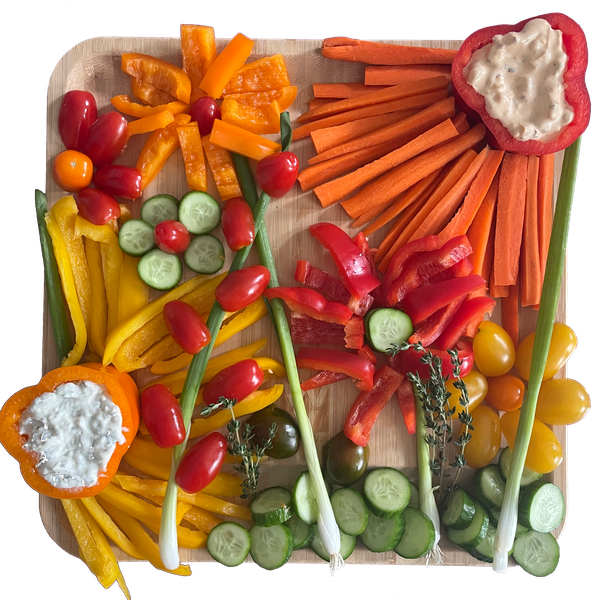

You’ve canned, frozen, dehydrated, and shared your fall harvest. But, of course, there is a lot left over. A great way to enjoy the last veggies of the season is to eat them cold and crisp with a variety of fun dips. This crudité platter incorporates all the best of the season’s harvest and is perfect for sharing with friends or bringing to a party. The best part? The presentation can vary depending on your mood or what vegetables you have on hand. For this platter we decided to make a flower design, but you can take this in any creative direction you like. You can make some homemade dips or buy some premade. Feel free to embellish with edible flowers or herbs (we used some springs of thyme). No matter what display you chose, make sure to have fun with it!
This article originally appeared in the September/October 2025 issue of Upstate Gardeners’ Journal.
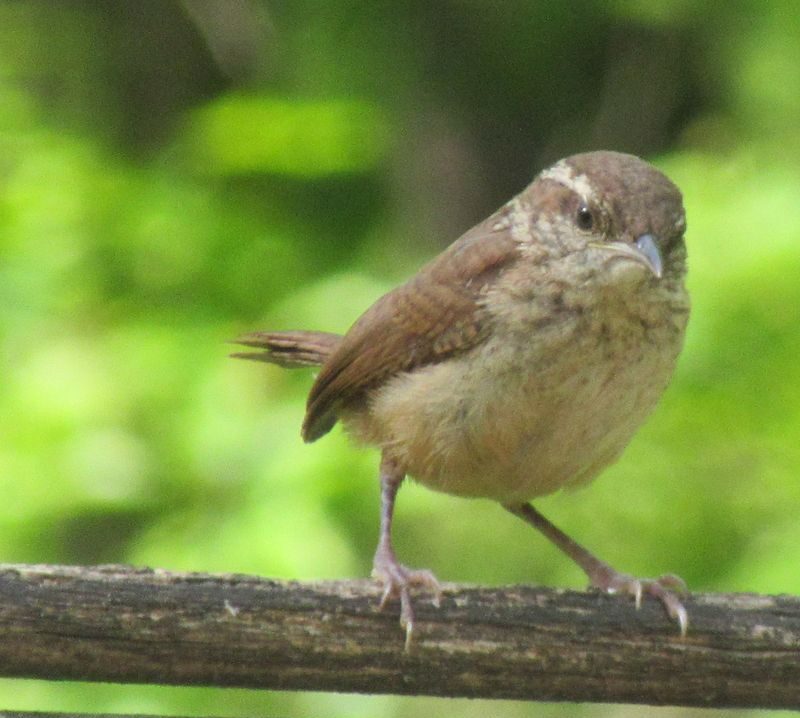
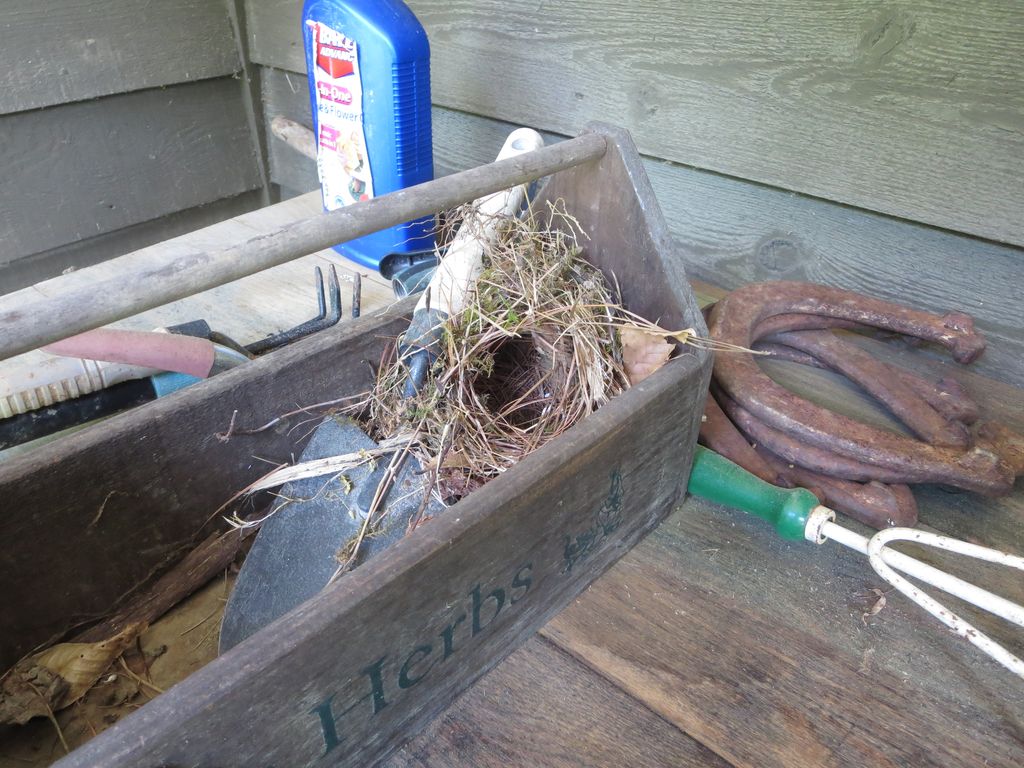
So often when we watch birds in their natural habitats, we see them singing, nesting, hunting, and more. The more you watch birds, you might start to notice behaviors they exhibit which can be quite confusing. Over the years I have gotten so many of the same bird behavior questions that I thought it would make sense to shed a little light on a few of them.
Birds will sometimes start randomly attacking, or repeatedly flying into, windows or car mirrors. This behavior is different than window strikes. Window strikes occur when birds do not see the glass of a window and fly into it unknowingly. Window strikes will often cause birds some kind of injury or knock them unconscious. The attacking of windows, however, is deliberate. Often when a bird is attacking a window, it is seeing its reflection and perceiving it as a rival bird who has come into its territory. This behavior is especially common in Cardinals, Mockingbirds, and American Robins in the spring during mating season. Usually the culprit is a male bird who is attempting to defend his territory from other birds. Putting decals or covers on the outside of the window or mirror can help curb this. This will help block the refection so the bird doesn’t see itself anymore. Fortunately, this behavior usually only lasts a couple of weeks and then it stops.
Besides hitting windows, another source of bird sounds you might hear at your house are birds pecking at places you do not want them to! Pecking at things like metal siding, mailboxes, and satellite dishes is common in the spring. This can cause a lot of noise and sometimes happens very early in the morning. Usually, this behavior of making very loud banging sounds is recognized as “drumming.” Drumming is a way birds, especially woodpeckers, communicate to other birds they have established their territory and are trying to attract a mate. You can also hear woodpeckers making drumming noises on wooden structures, especially hollow trees where sound travels very well. If you have woodpeckers pecking on the side of your wooden paneling, it could be this behavior or they could also be looking for insects inside the wood.
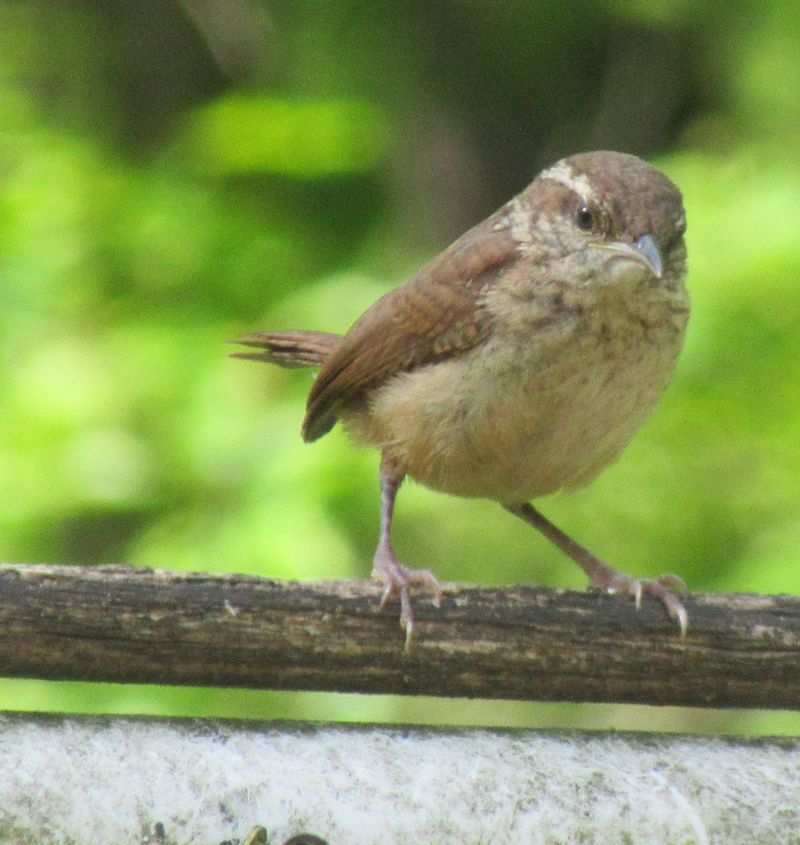
It’s common to hear birds signing in the morning and throughout the day, but sometimes songbirds will sing in the middle of the night! The most common birds to hear singing well into the evening are American Robins and Mockingbirds. These songs are again most often sung in order to establish territories and attract mates. Having the ability to sing not only during the day but well into the night shows potential mates the fitness that particular bird has and can help them to attract a mate. The stillness of the night also helps the sound travel further. Usually this behavior happens with unmated males and tends to be more common on nights with bright moonlight.
Have you ever gone to get the newspaper out of your delivery box and found you have a friend building a nest there? Some birds are known to nest in places we would consider unconventional. One of the best examples of this are wrens. Carolina and House Wrens are cavity nesters who will actively build nests in birdhouses and hollow spots in trees, but on top of this I have heard so many stories of them nesting in very interesting places! Wrens are known to fly into garages to nest in the eaves, will nest in planter boxes, shoes and boots that were left outside, and we have even seen pictures of a wren nesting in pocket of some shorts that were hanging on a clothesline to dry! This behavior of nesting in and close to human structures most likely has something to do with why the Carolina Wren has been expanding its range in the U.S. so well.
I had a confusing experience this spring witnessing a Blue Jay behaving in a way I had never seen before. The bird was sitting on the ground with its feathers splayed out, beak open and not moving. I thought the bird was injured, but as I got closer it flew away with ease. It wasn’t until doing some research I realized it was in the middle of a behavior called “anting.” Anting is when a bird will let ants crawl onto its body and feathers. It is believed that the ants, which produce formic acid, can repel parasites or possibly sooth the skin of the bird when they make contact with its body. Sometimes birds will even do what’s called “active anting” where they will pick up ants and rub them on their feathers. Another behavior that is similar to this is dust bathing. Birds will often hop around in dry dirt or sandy surfaces and fluff it over their feathers, sometimes even rolling in it. This behavior helps remove mites, lice, and excess oil buildup on the feathers which keeps their feathers, and thus the bird, clean and healthy.
Birdwatching is a fun hobby in many ways . . . especially when you never know what kind of bird you will see, and you never know what kind of behavior they will be exhibiting!
Liz Magnanti is co-owner of the Bird House in Brighton, NY.
This article originally appeared in the September/October 2025 issue of Upstate Gardeners’ Journal.
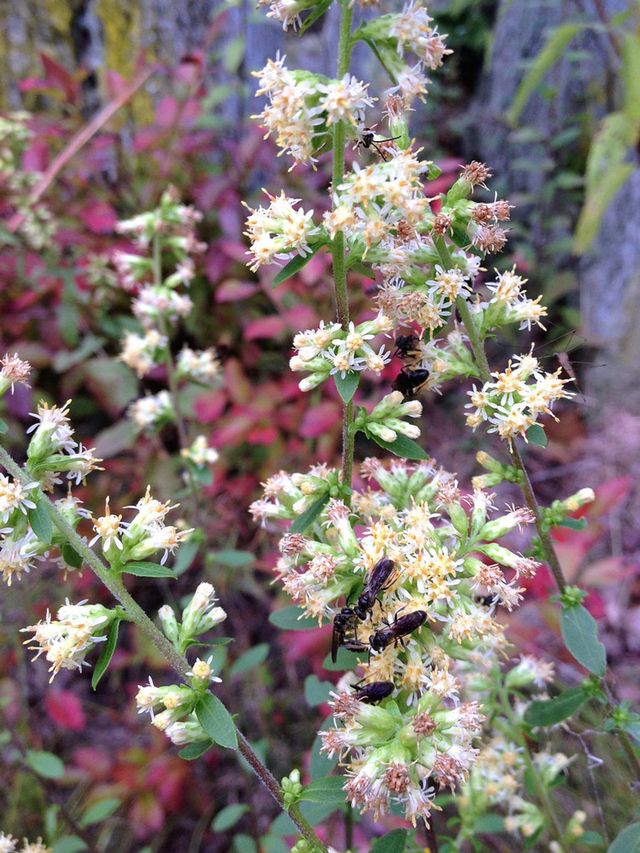

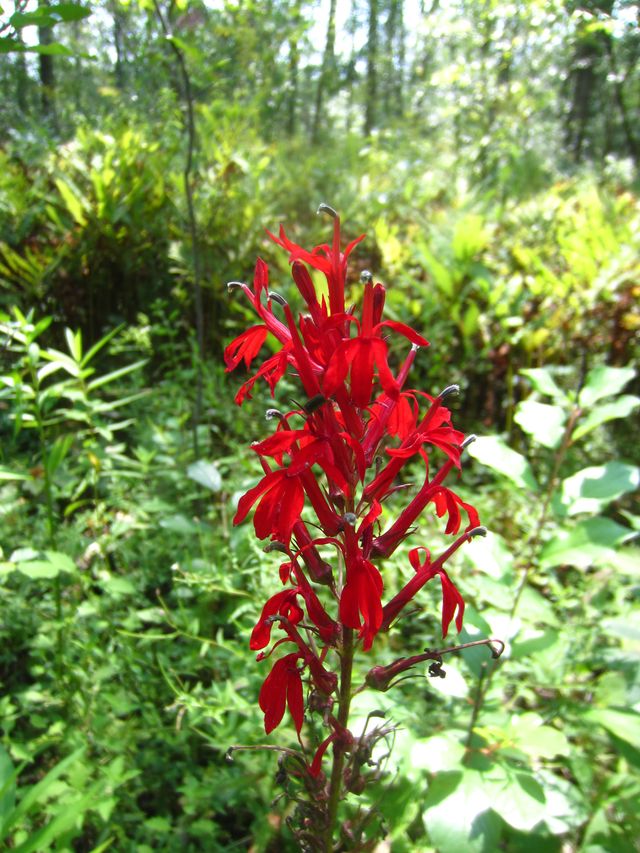
Autumn is an ideal time to add native plants to your garden that are popular with pollinators. Cooler temperatures, warm soil, less water stress and limited weed competition encourage strong root growth. Douglas W. Tallamy, American entomologist, ecologist, conservationist and author, explains “ . . . we humans have disrupted natural habitats in so many places that the future of our nation’s biodiversity is dim unless we start to share the places in which we live . . . with the plants and animals that evolved there.” Tallamy stresses, “Our success is up to each one of us individually. We can each make a measurable difference almost immediately by planting a native nearby. As gardeners and stewards of our land, we have never been so empowered—and the ecological stakes have never been so high.”
With more than fifteen native goldenrod (Solidago) species populating Western New York counties, planting options are mind-boggling! The forest goldenrod (Solidago arguta) is a clumping perennial that grows two to three feet tall in medium to dry soil. It spreads by seed, not rhizomes. Forest goldenrod blooms beautifully in full shade, providing nectar for woodland insects in the fall when many other plants have already stopped blooming.
White goldenrod (Solidago bicolor) is a clumping, herbaceous perennial that grows well in dry (often poor) soil in full sun to partial shade. It seems to prefer soil with a heavy clay content and tolerates drought. White, bell-shaped blossoms climb the elongated stem in a spiral formation. The flowers attract butterflies and bees in late summer and birds love the seeds. The sap of the goldenrod is toxic, so deer and rabbits avoid this plant. White goldenrod is the only species of solidago found on the east coast with white rays. It is easy to grow, low maintenance, and trouble-free.
The slender, purplish, arching stems of blue-stemmed goldenrod (Solidago caesia var. caesia) grow one to two feet tall. Both branched and unbranched stems display scattered clusters of yellow flowers. The large terminal cluster is composed of arching sprays of tiny golden blooms. It is shade tolerant, grows in dry soil, and is not aggressive, spreading slowly by underground creeping rhizomes or by seed. The blue-stemmed goldenrod is a magnet for butterflies, moths, bees, wasps and beetles.
Within the Campanulaceae family of more than 400 species of lobelia, several are native to Western New York. The cardinal flower (Lobelia cardinalis) produces an erect inflorescence about 28" tall bearing vibrant red flowers during the summer and fall. Its overall height is four feet and it prefers moist to saturated soils. Two additional native lobelia species include Indian tobacco (Lobelia inflata) and the great blue lobelia (Lobelia siphilitica). All three plants display the typical “lip” petal near the opening of the flower, which is common to the genus. They also produce a milky sap containing latex, which oozes out when the plant is cut or bruised. The latex is a crucial part of the plant’s defense mechanism against herbivores and pathogens.
Indian tobacco (Lobelia inflata) is an annual with small, pale lilac-colored flowers and tiny white dots along the leaf margins. It grows from six to thirty inches tall in full to part sun in moist soil but will also grow in gravel and poor soils. Indian tobacco does not mind competition from other plants so it will intermingle happily in existing gardens. It attracts small bees while deer sidestep it due to its high toxicity to mammals.
The great blue lobelia has violet-blue flowers and is pollinated by bees whereas the cardinal flower is primarily pollinated by the ruby-throated hummingbird. This is the only breeding hummingbird species found in New York State.
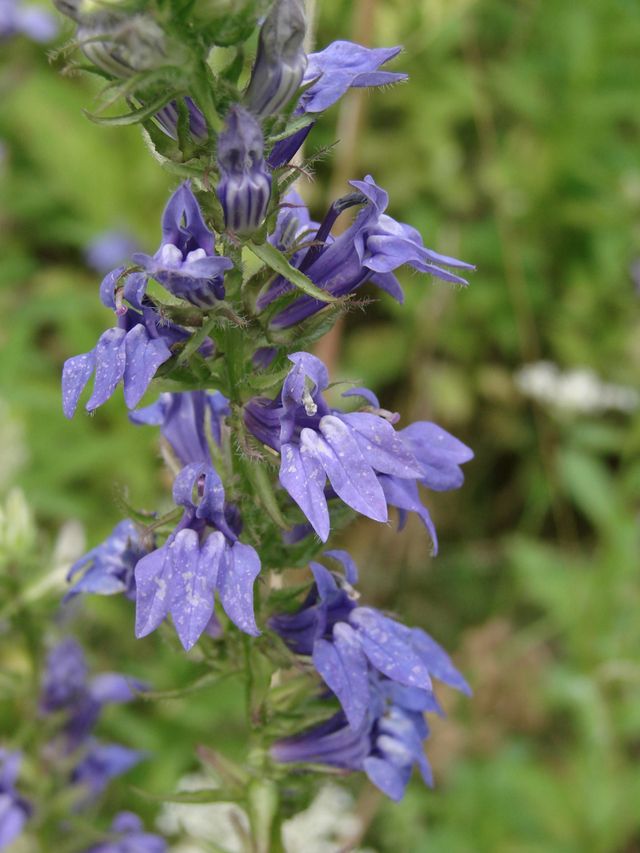
JUST CHILLING . . .
Many pollinators hibernate during the winter by pausing their development and hunkering down until spring. This state of dormancy is defined as diapause. During this hiatus, incredible protective strategies are activated to help the insects survive in extreme conditions. Adding more pollinator habitat is key in winter.
Small carpenter bees, mason bees, yellow-faced and leaf cutter bees carve out their nests inside dry, hollow stems and spend the winter under cover. Leaf piles are essential shelters for hibernating bumblebee queens and the larva of numerous moth and butterfly species. Mulch attracts beneficial insects like lady beetles who are ready to attack pesky aphids once spring arrives.
Native bees, including mining bees and bumble bees, overwinter as larva by tunneling deep into the ground. Dragonflies, in nymph form, overwinter beneath the ice. Predatory beetles such as tiger beetles remain mostly dormant inside and under old logs. Praying mantises survive the winter by laying eggs on a vertical surface such as a plant stem, rocks or fence post. Firefly larvae like to overwinter in decaying pine logs, at the base of trees or underneath loose bark.
THE ROLE OF NATIVE PLANTS IN THE WINTER GARDEN
Since native grasses have a long growing season and retain their structure through winter, they can provide four seasons of resources and habitat for pollinators and other wildlife. Their extensive root systems (measured in feet) help store carbon in the soil, impede stormwater and reduce erosion thus boosting their ecological value.
In the Poaceae family, switchgrass (Panicum virgatum) is a larval host plant for moths and butterflies. It is a long-lived perennial that grows two to five feet tall and spreads slowly by short rhizomes. The seed plumes linger well into winter, providing food for songbirds. Little bluestem (Schizachyrium scoparium) produces silvery-blue shoots in spring with the blades turning a dazzling reddish-tan in the autumn. It grows best in full sun. The fuzzy white seeds are beneficial to small birds in winter.
Yellow indian grass (Sorghastrum nutans) is a showy, tall perennial with soft, plume-like, golden seed heads. Broad blue-green blades stay low most of the year, then grow three to eight feet tall before blooming in early autumn. This bunching grass develops rich gold and purple seeds and panicles and deep orange to purple blades. Yellow Indian grass will grow in sun or shade and dry or moist soil and is drought tolerant. Granivorous birds eat the seeds and use the leaf blades for nesting material. It is the larva host for the Pepper and Salt Skipper butterflies.
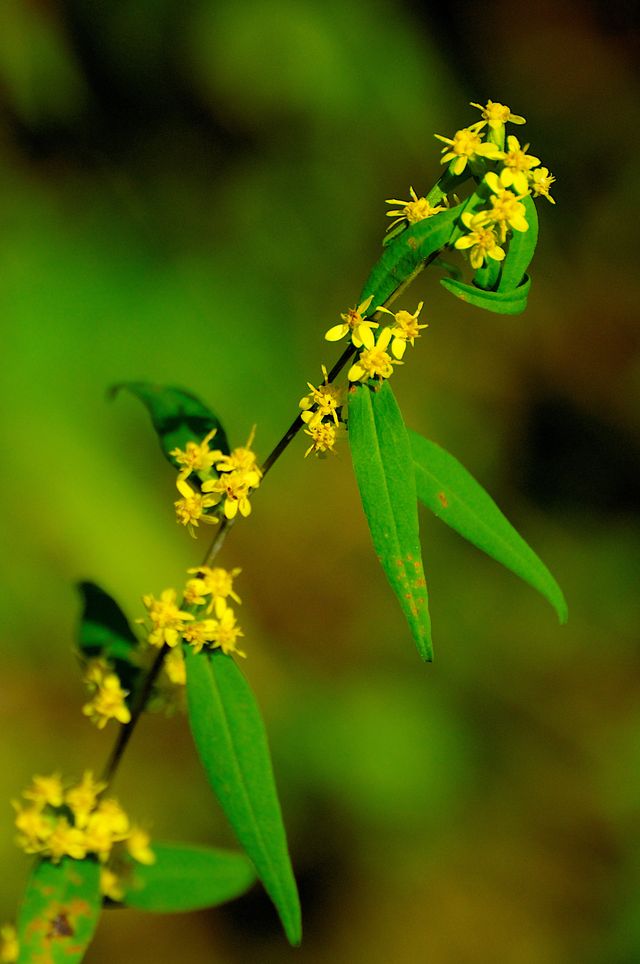
WHAT ABOUT THE BIRDS?
Many birds overwinter in Western New York, including the black-capped chickadee, the northern cardinal, the tufted titmouse, the downey and pileated woodpecker, and the barn owl. Grasses provide birds with seeds, nesting materials and shelter.
“Birds are the lynchpin of every garden,” explains Monty Don, British horticulturist, broadcaster, and writer. “The more birds you have, the more snails and slugs get eaten.” Birds are important members of the food chain, providing natural control of mosquitoes, Japanese beetles, whitefly, scale insects, and aphids.
This fall and winter, invite pollinators to your garden by planting just one fall-blooming native or an ornamental grass with attractive seedheads for the birds to nibble on. Support insects, reptiles, birds, and small mammals by creating an environment rich in habitats using leaf litter, logs, branches, and mulch. Install nesting boxes, birdhouses, and feeders to enjoy the winter activities of wildlife. You and your garden can make a difference!
USEFUL RESOURCES FOR NATIVE PLANT RESEARCH
Bringing Nature Home by Douglas W. Tallamy Audio and Ebook available on Hoopla
The Northeast Native Plant Primer by Uli Lorimer Ebook available on Hoopla
Native Plant Gardening for Birds, Bees & Butterflies: Northeast by Jaret C. Daniels Ebook available on Hoopla
New York Flora Atlas: newyork.plantatlas.usf.edu
Colleen O’Neill Nice is a horticulturalist who is passionate about plant propagation and enjoys nurturing her garden in Clarence, New York.
This article originally appeared in the September/October 2025 issue of Upstate Gardeners’ Journal.
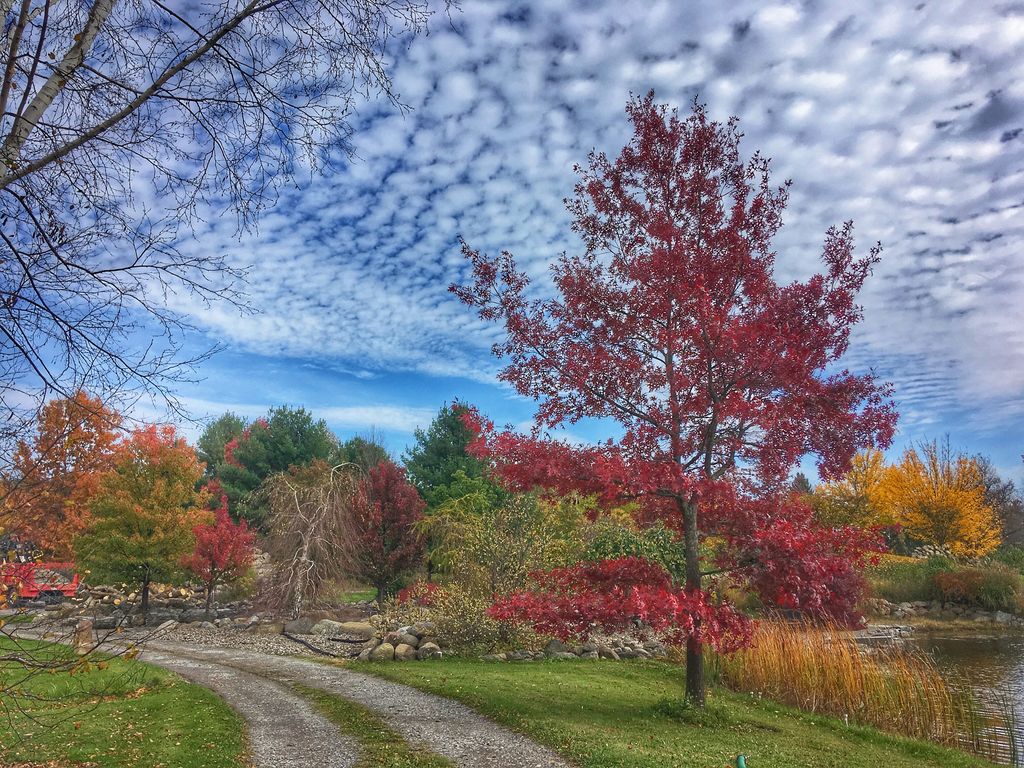

Ah, autumn. If I am forced to choose one of the four seasons in which to live in perpetuity, the season of sweater weather would be it. While at times the ending of gardening season can be bittersweet, the majestic crescendo with which it ends more than makes up for it in my book. And by fall, we’re all ready to rest a bit, aren’t we?
But first—fall foliage! I have always lived in areas rich with a variety of deciduous trees that shed their leaves as they enter winter slumber, and I feel the garden—and gardener—do much the same. Big bright blooms are everywhere in the early fall garden, and I am there to soak up every last one, while also taking this great opportunity to plant a few choice woodies and perennials, in addition to savoring the last harvests of my vegetable patch. But after the abundant harvest season comes a season of rest, for both the garden and the trees. We shed the daily tasks of gardening, and the trees . . . they shed their leaves.
Some of my favorite memories are tied to fall foliage, from raking leaves into jumping piles with my grandmother to my annual leaf collection walk tradition. I now live on a farm, and leaf raking is a thing of the past. My leaf collecting walk tradition, though, is very much alive, now accompanied by my daughters and most likely a goat or two.
I try to take a leaf collection walk multiple times in the fall, as different trees lose their leaves at different points of the season. As I walk, I make a bouquet of as many different shapes and colors as I can find. Sometimes I pick up an acorn or any seed pods I see. When I get back home, I spread them all out and try to identify the trees from my leaf collection. I’ll often take tree bark pictures near where I picked up a leaf to help with the identification process.
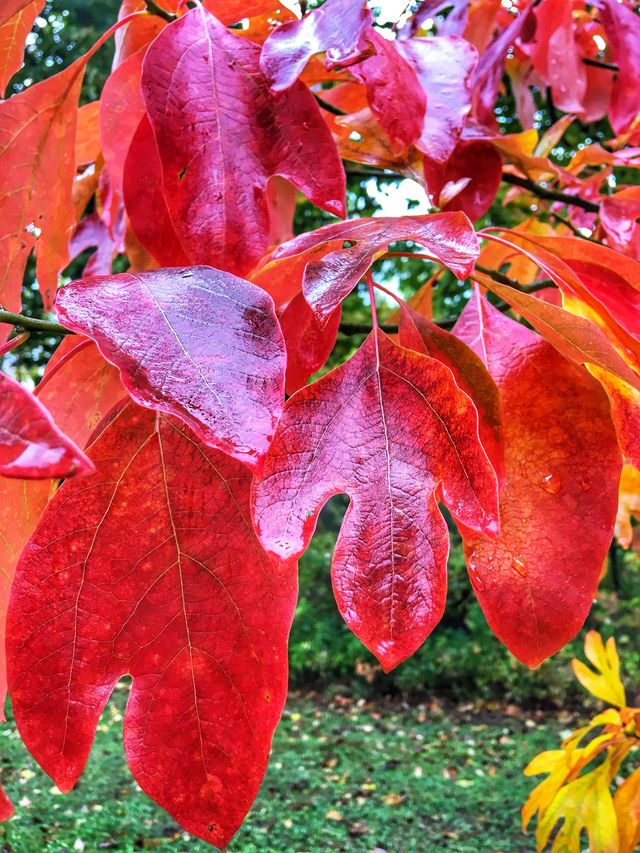
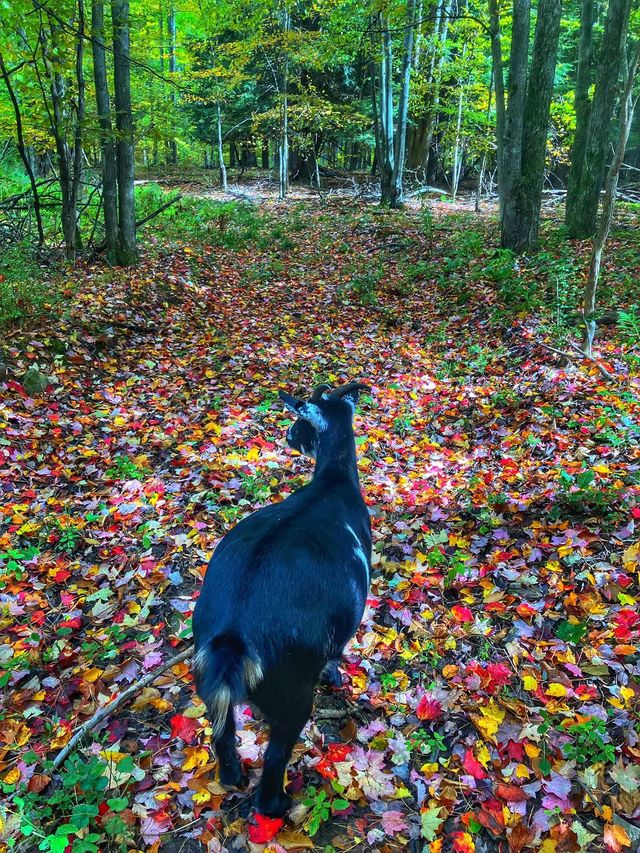
Every fall leaf is a thing of beauty, but there are some foliage treasures that get me really excited on my leaf collecting walks. The first leaf that comes to mind is unique: sassafras (Sassafras albidum), a native understory tree. Sassafras trees have three different shaped leaves—a simple, unlobed oval, a mitten-shaped leaf with one lobe, and a three-lobed leaf. If you crush a sassafras leaf, it has a sweet, citrusy-vanilla scent to it. The fall color profile of the sassafras is a bold mixture of orange, red, and a burgundy purple, with yellows mixed in as well.
While it seems most leaf peepers ooh and ahh the most over the bright oranges and reds, I am a lover of the bright yellows that ribbon through the colorful woods. Trees like aspen, ash, elm, ginkgo, and some maple species come to mind. My favorite fall yellow display, however, would have to go to the larches (Larix spp.). Larch trees are deciduous conifers, so you might not notice them much in the growing season if you are unfamiliar with them. But come autumn, their stately arches of branches are covered in tiny yellow needles, giving the towering pyramids a golden glow.
My third favorite leaves are from the oaks (Quercus spp.). Oak leaves are some of the last of the season to fall, and while there is quite a variety of oaks, their distinctive lobes are some of the easiest to spot and tend to be shades of brown with some reddish–burgundy in some species. But what makes oak leaves special to me is their texture—they are quite stiff and crispy and create the best crunch when you walk through a pile of them.
When I was deployed overseas, my mother sent me a box of autumn leaves as part of a care package. When I opened the box, the smell was unmistakable autumn, and the leaves had turned crisp, although I’m certain my mom had selected them as freshly fallen specimens. I remember at first wanting to carefully lay out each one, and make a garland, but then, giving in to the childhood memories they invoked, I thrust the box upward and let the leaves fly above me, and then fall around me on the bed and floor. It was my own personal falling leaves party in the desert, a memory I will always treasure. New York is rich when it comes to fall foliage, whether it be in one of the many parks, or a wooded lot in our own neighborhood. I’d like to share my personal top favorite places to enjoy the autumn leaf displays.
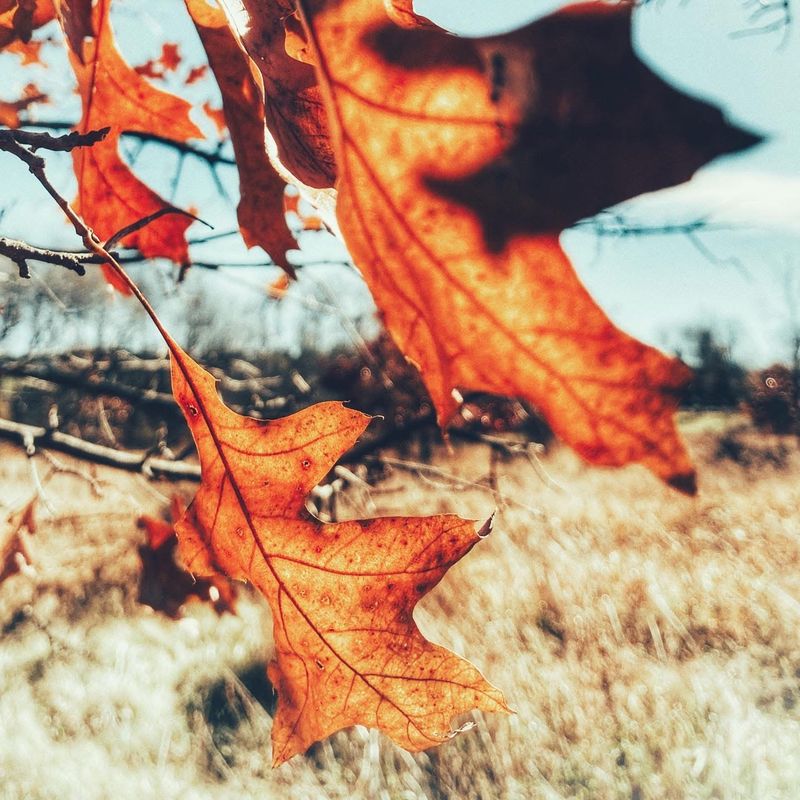
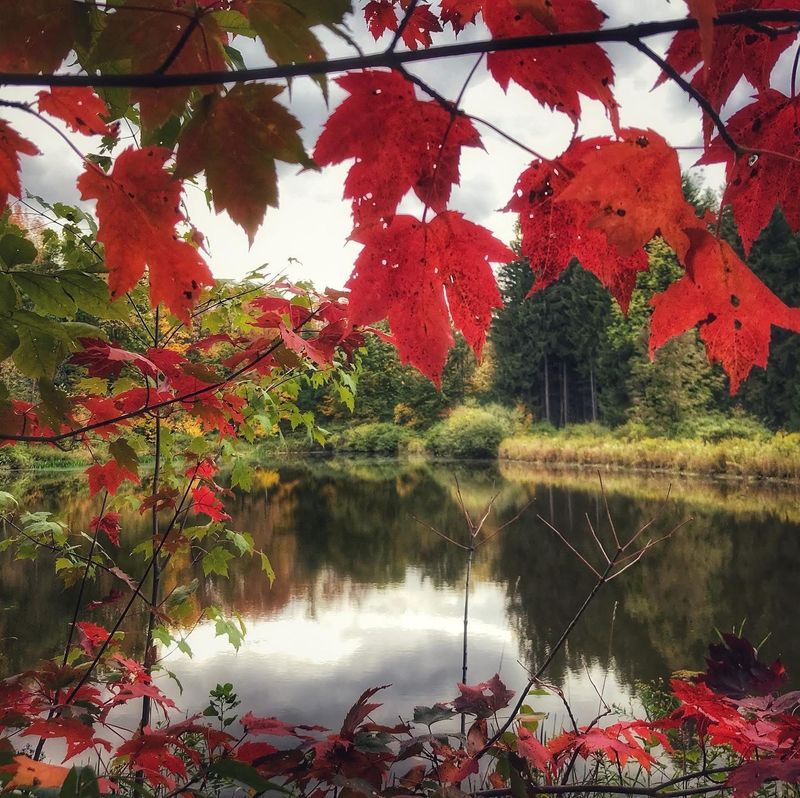
1. Draves Arboretum, Darien, NY
Top-notch for variety, this regional treasure boasts more than 900 trees and shrubs from all over the world. While you might find it hard to decide when “peak” is here, there will undoubtedly be a sizable collection of color throughout the autumn season. Though it is hard to pick a favorite section, the views in the Sanctuary Section are a symphony of texture and autumn color.
2. Boyce Hill State Forest, Franklinville, NY
If you are looking for a quiet, secluded place to wander among the falling leaves, this state forest, which is also a part of the Finger Lakes Trail, has it all. A large pond on the edge of the woods makes for beautiful reflections of the maple leaves against stands of evergreens. You can turn your leaf hunt into an overnight trip in a lean-to, which is first-come-first-serve, or at a primitive camp site by the pond.
3. Fort Niagara and Four Mile Creek State Parks, Youngstown, NY
I put these two together because they are connected by Lake Ontario. Four Mile Creek is, as aptly named, four miles from the mouth of the Niagara, where the fort sits. The oaks in the Fort Niagara State Park are old and majestic. You can take an easy stroll or bike ride down Scott Avenue, a road not open to vehicular traffic that runs along the river. Not only are there great views of the fall foliage along the river banks, the park itself has generous oak stands, sprinkled with a quality variety of more recently planted tree species. I include Four Mile Creek for a single trail near the outlet that contains a decent wild stand of my above mentioned favorite, sassafras. Be sure to find one of each of the leaf shapes: the oval, the three-lobed, and the mitten leaf!
Bonnie Warriner is a horticulturist and budding flower farmer with a love for capturing beauty in pictures and words. You can find her among the wildflowers and goats on her family’s 150 acre farm in Jasper, New York.
This article originally appeared in the September/October 2025 issue of Upstate Gardeners’ Journal.
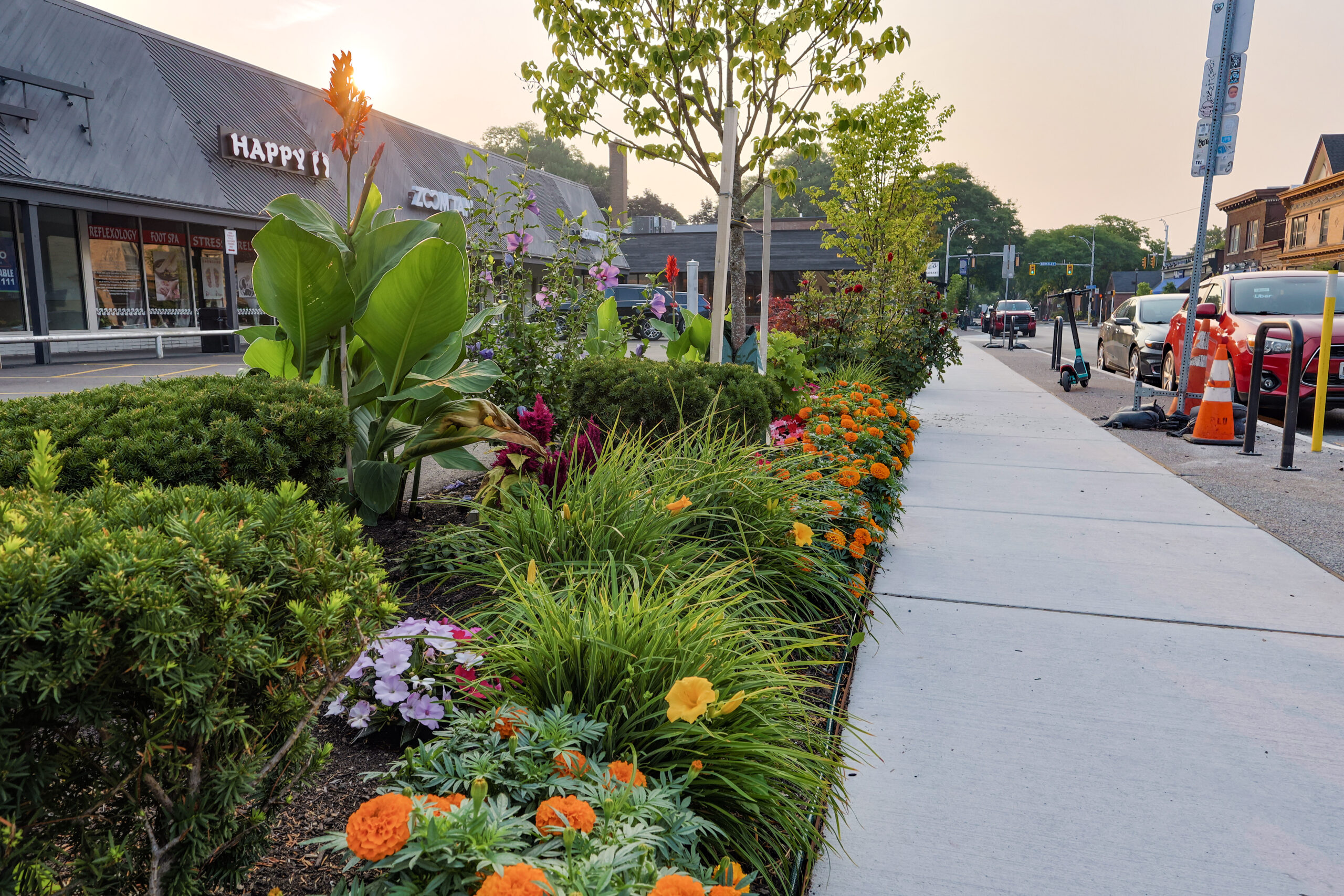

BUFFALO AND ERIE COUNTY BOTANICAL GARDENS BEGINS HISTORIC EXPANSION
The Buffalo and Erie County Botanical Gardens has launched a transformative $31 million expansion and renovation designed to elevate educational offerings, community programs, and visitor experiences for generations to come.
Construction began in June and is expected to conclude in early 2027. The project includes more than 14,000 square feet of renovated space, 16,000 square feet of new construction, and more than 90,000 square feet of expanded outdoor gardens—marking a significant evolution of this historic Western New York destination.
Governor Kathy Hochul emphasizes the importance of the upgrades, calling the gardens a peaceful retreat and educational hub, even in Buffalo’s harsh winters. “Improvements to this historic tourist destination create a space for events, kids’ camps, and educational classes to grow—ensuring a bright future for one of Buffalo’s most treasured attractions,” Hochul says.
New features include a welcome center, the Garden Market Café, an expanded gift shop, Learning Lab classrooms, a year-round event venue called the Canopy, a solarium greenhouse, outdoor terrace, revitalized horticulture center, and a central courtyard for artwork and plant displays. Sustainability upgrades include solar panels, stormwater systems, and energy-efficient design. Accessibility improvements include a relocated entrance with drop-off area, all-gender and family restrooms, a parent room, visitor lockers, and improved pathways.
The expansion supports the mission to connect people and plants through immersive experiences. It will enable expanded programming such as school field trips, summer camps, adult learning, art exhibitions, and community events.
The Growing Beyond the Glass capital campaign reflects the institution’s goal of serving the community beyond the historic conservatory. President and CEO Erin Grajek says, “This is more than just construction—it’s a commitment to providing extraordinary experiences for generations to come.”
New York State is contributing $12 million in capital grants, including $10 million from the Regional Economic and Community Assistance Program. Additional funding comes from Erie County, federal sources, corporations, foundations, and private donors. With 94% of funds secured, the campaign is working to raise the remaining $2 million.
The conservatory remains open during construction, and free parking is available. Visit buffalogardens.com for more information or to contribute.
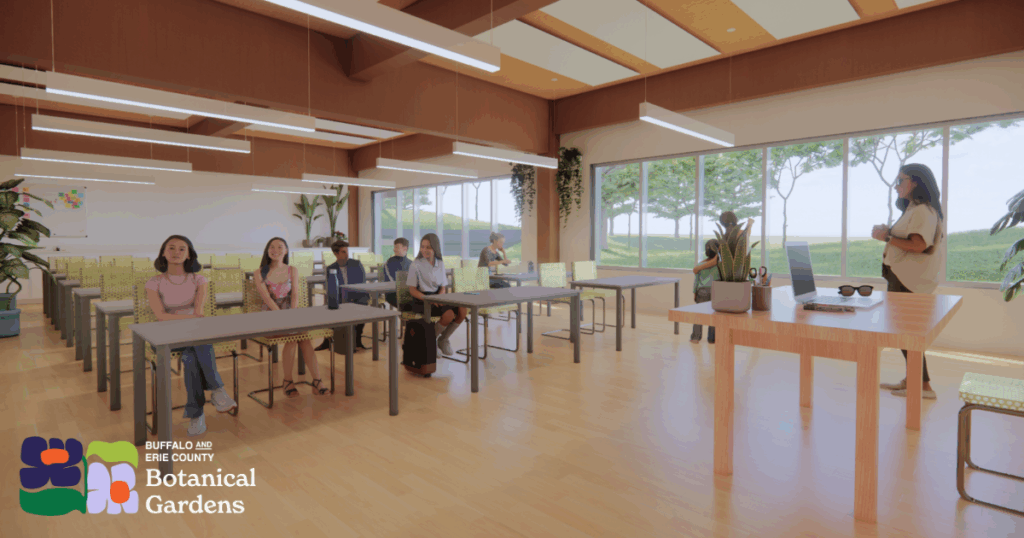
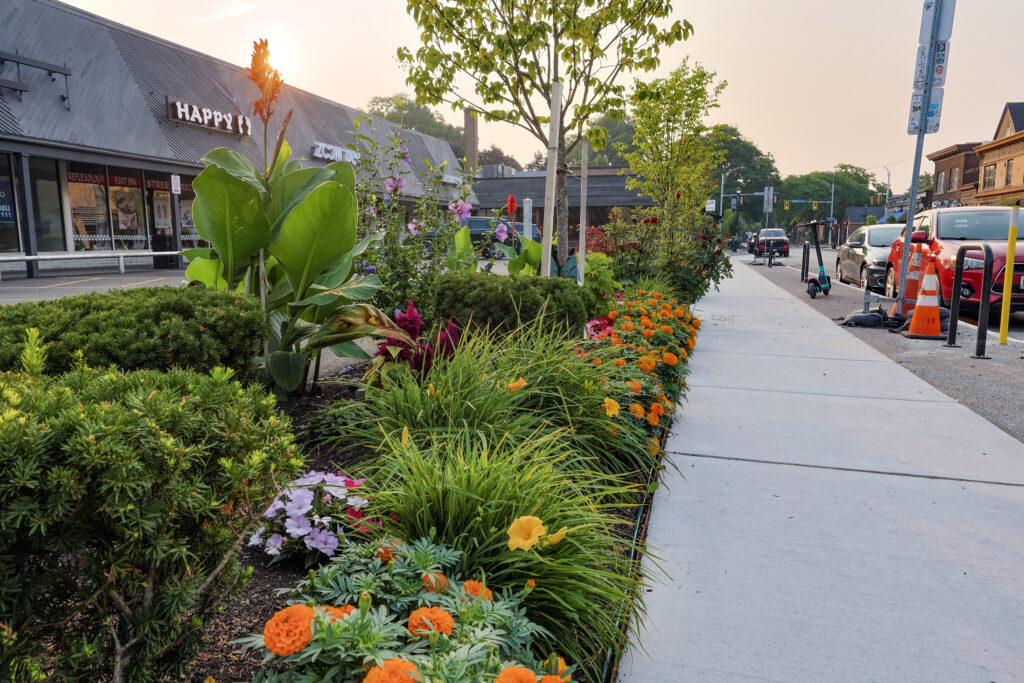
A GARDEN GROWS ON PARK AVENUE
In the median outside the Park–Berkeley Plaza in Rochester, colorful annuals, perennials, and ornamental plants now blossom in a once-plain patch of land—transformed into a quietly striking garden by a small group of residents seeking to beautify their surroundings. SunPatiens, canna lillies, dahlias, hosta, marigolds, sunflowers, roses of Sharon, hydrangeas, tulips, daffodils, and irises share space with boxwood hedges and city-planted trees, creating a vibrant seasonal display.
Another blooming plot can be found outside the administrative building next to Asbury First United Methodist Church on East Avenue. This garden is managed primarily by church members and reflects the same informal mission: improving one small space at a time.
“It’s really a group effort,” says one gardener (who wishes to remain anonymous) involved in both spots. “People offer what they can—canna lilies, dahlia bulbs, or just help with maintenance—and somehow it all comes together.”
This isn’t a city program or nonprofit initiative. Just neighbors, business owners, friends, and families pitching in to make their neighborhood feel more cared for.“We didn’t set out to start a movement,” the gardener adds.
“We just wanted to revive the space in front of us—and maybe inspire someone else to do the same. A healthy neighborhood needs evidence of life. Gardens provide that. They signal hope and a willingness to nurture something.”
The next project lies just up the street, near the Bank of America and CVS. With a little teamwork and a lot of heart, it’s sure to bring another touch of beauty to Park Avenue.
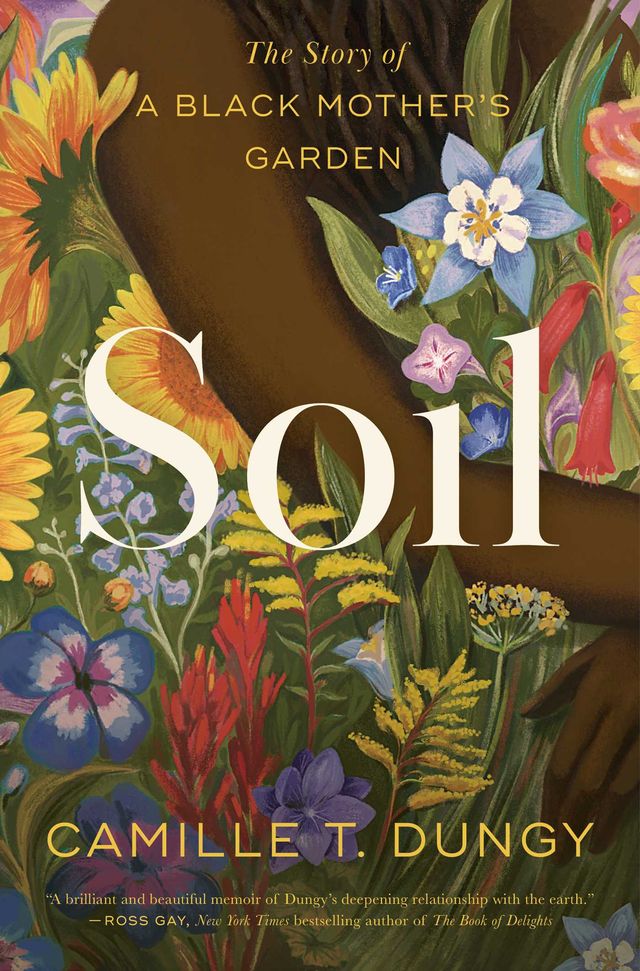
SOIL BY CAMILLE T. DUNGY
Award-winning poet, essayist, and memoirist Camille T. Dungy will visit Rochester this October as part of Writers & Books’ Rochester Reads 2025 series. Dungy is the author of Soil: The Story of a Black Mother’s Garden, a critically acclaimed memoir weaving gardening, environmental justice, race, and motherhood.
The keynote and book signing will take place Thursday, October 9, from 7 to 9:30 p.m. at the Memorial Art Gallery, 500 University Avenue, Rochester. The evening will explore Dungy’s journey to transform her suburban Colorado yard into a biodiverse, ecologically rich landscape, while confronting the cultural and systemic barriers that shape who is seen as a gardener and what is valued as a garden.
Tickets are available on a gift economy basis (free to $50). An intimate pre-event reception with the author runs from 5:15 to 6:30 p.m., with tickets priced $90 to $150.
Soil has been praised for its lyrical prose and powerful cultural critique, with award-winning poet and essayist Ross Gay calling it “a brilliant and beautiful memoir of Dungy’s deepening relationship with the earth as she considers questions of family, history, race, nation, and power.”
“We’re thrilled to welcome Camille T. Dungy to Rochester,” Writers & Books executive director Alison Meyers says. “Her work opens crucial conversations about who is included in environmental narratives and how gardening can create justice as well as beauty.”
For tickets or details, visitwab.org.
Elise Williams is a Rochester-based writer who always takes time to stop and smell the roses—and, of course, the lilacs.
This article originally appeared in the September/October 2025 issue of Upstate Gardeners’ Journal.
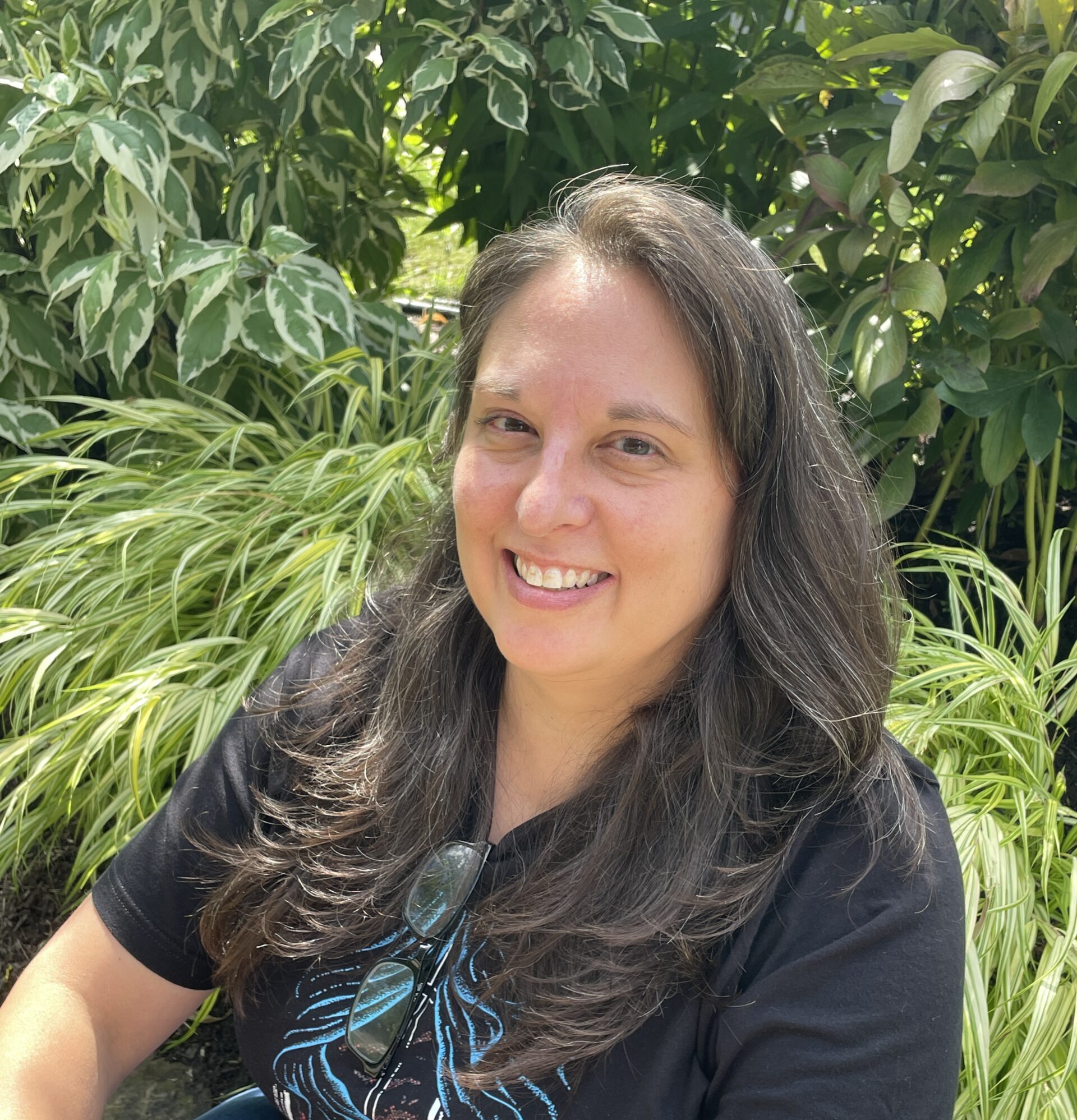
The fall garden is a precious thing. Veggies, fruits, herbs, and flowers are in abundance, the weather starts to cool, and the mosquitoes disappear. Yes, there is still a ton of work to do, especially as we near the end of October and need to prepare for winter. But the work doesn’t seem to matter when I look around and see what the summer has gifted me: twelve-foot-tall sunflowers, calendula blooms to make my yearly batch of hand cream, lavender ready to dry and gift to friends, and herbs galore.
You may remember from a previous letter that I lost a big old maple tree that boasted the prettiest yellow leaves every October. I’ll miss those lovely leaves even if the raking was a little annoying. But thanks to Bonnie Lynne Warriner’s article, I know that I can go to many local sites where I can collect leaves for crafts, décor, and just for fun.
What is your favorite part of a harvest-time garden? Tell me about it: [email protected]

This article originally appeared in the September/October 2025 issue of Upstate Gardeners’ Journal.


As she hopped off the city bus into stifling heat, my mom looked down the street and let her eyes adjust, trying to confirm that what she saw was real: her husband and three children galloping toward her in questionable outfits, looking like an Insanity Quartet. There was fabric flying where fabric shouldn’t be. As our designated stylist, my mom noticed immediately that we were not wearing the clothes she left out for us that morning.
With mom at work, our dad was left in charge today, and we all knew what that meant: Normal routines were much looser. Compared to the detailed planning my mom leaned on to keep everything running smoothly, Dad was more of a bottom-line guy: are the children alive and in one piece? Yes. Well then, mission accomplished.
Before she left for work, my mom picked out outfits for me, four years old; my sister, two and a half years old; and our baby brother, coming in hot at nine months old. Mom learned quickly that my dad was not cut out for wardrobe consulting. Earlier in the year she set out two sets of clothes for my day at preschool: one if it was chilly and one if it was hot. By the time she picked me up from school, I was a sweaty mess. She started investigating and discovered that my dad put me in BOTH sets of clothes. He even went to the trouble of putting my socks on underneath my stockings, stating that he knew my mom was “picky about that stuff.” From then on, mom made every effort to ease the burden of getting three unruly toddlers dressed at the same time. That day, she even laid out socks and accessories, but with Dad at the helm, all sartorial hell broke loose. When The Stylist’s Away, The Aspiring Fashionistas Will Play.
First, we’ll tackle my coup: There was a heavy, lace-adorned dress at the back of my closet that I had been eyeing for months. It was three sizes too big, but my mom stored it there for when I finally grew into it. Without my mom around to stop me, I pulled it from the reserves and gleefully put it on. The lace was too heavy for the summer heat and was more appropriate for, say, dinner with the queen than for watching cartoons at home. But I was not about to let logic pull me away from the fashion fast track.
We now turn our attention to my sister’s tantrum. She spotted the green corduroy overalls laid out for my brother and lost her mind. The overalls used to be hers; once she outgrew them, they were handed down to my brother, who was now baby du jour. Since they were her favorite overalls, she wouldn’t let them go without a fight. Rather than put up with her histrionics, my dad relented, and my sister reclaimed her pants. Baby bro is out of luck.
Already exhausted from dressing us, my dad announced that it was time to go to the bus stop to walk my mom home. My sister and I were pumped to show off our fashion victories and happily bounced out of the house. As the bus pulled up, we waved and ran toward my mom, who was befuddled by what she saw:
I led the pack, flapping my arms up and down as my lace parachute fluttered aggressively in the breeze. There was so much fabric flying that my mom worried I would lift off the ground and float away. That couldn’t happen, though, because I was anchored to the sidewalk with a chunky pair of Winnie the Pooh boots. Winnie the Pooh winter boots. In the middle of July. Lest my ankles get too hot inside the wool lining of said boots, I shielded them with a pair of teal green striped knee-highs that I stole from my sister Brooke’s closet. Brooke was a teenager, I was enamored with her wardrobe, and I sneaked into her closet and stole things at every turn. Brooke, being older (and taller) than me meant that her socks reached up to my waist, which only added to my confused aesthetic. I skipped toward my mom in a bubble of euphoria; a child who knew they’re hitting all the fashion high notes.
A few yards behind me, in a more labored strut, was my sister. Being that she had long outgrown the baby overalls she insisted on wearing, the inseam and bib straps did not accommodate her height. As she walked, she bent over at a forty-five-degree angle. The impaired gait didn’t bother her though, because she was buoyed by the confidence of a mercurial toddler who knew she’s won her battle—and that’s what really matters.
Closing out the runway of this deranged fashion show was my poor, outgunned father. He is battle worn, but his job was done: All the kids were alive and dressed. Well, almost. Don’t forget that the outfit intended for baby bro was now crammed onto The Hunchback of Toddler Dame. Dad was all done problem solving by the time it came to my brother, who didn’t get any clothes that day. Instead, he was carried down the street in a diaper—and nothing else.
As she walked to meet us on the sidewalk, mom let this full picture of family chaos wash over her and decided to claim us anyway. We all went home together, and I’m sure my father did his best to shake off this ordeal and brace himself for the next one—because when you have little kids, there’s always a new ordeal right around the corner. But a lesson was learned that day: If fashion is just a gateway for self-expression, The Day the Toddlers Dressed Themselves offered my parents a glimpse of what life is like with children who are equal parts creative and strong-willed.
This article originally appeared in the September/October 2025 issue of (585).
Lunatics lounge
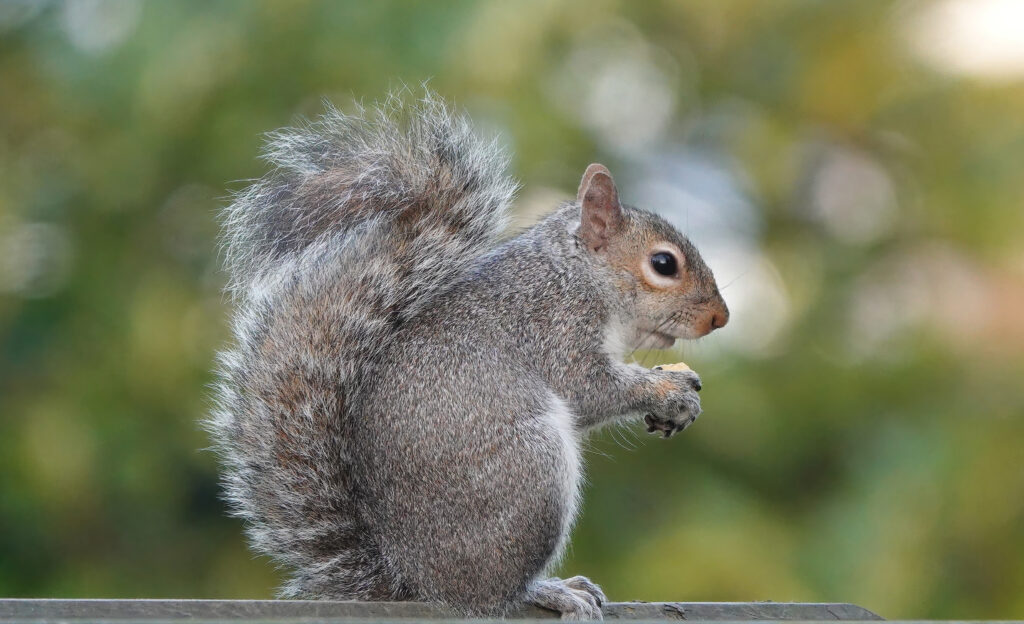
If you ever put up a birdfeeder, you might find that soon enough you are getting more than just birds. Squirrels are very good at

This fresh salad is the perfect light lunch on a nice spring day. Pair it with grilled chicken or shrimp and a loaf of crusty
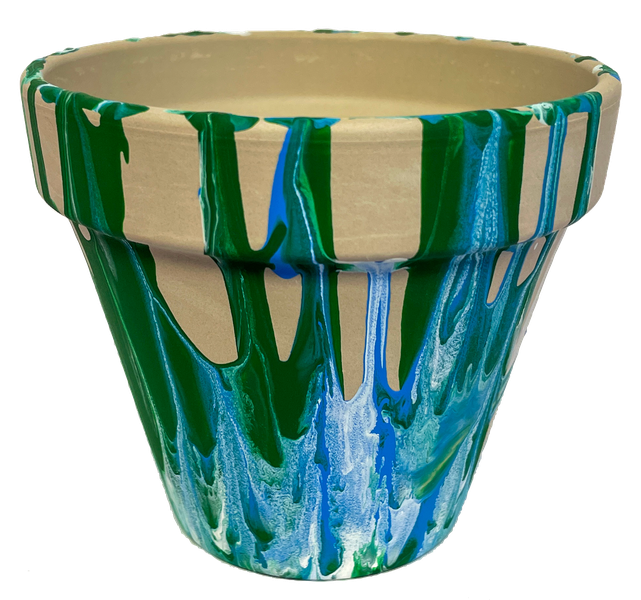
Dress up a plain flower pot with an easy pour-paint method. The most time-consuming part is waiting for the paint to dry. This is a

The task of creating a dedicated vegetable garden can feel overwhelming—carving out a large chunk of your yard to create the perfect growing space isn’t
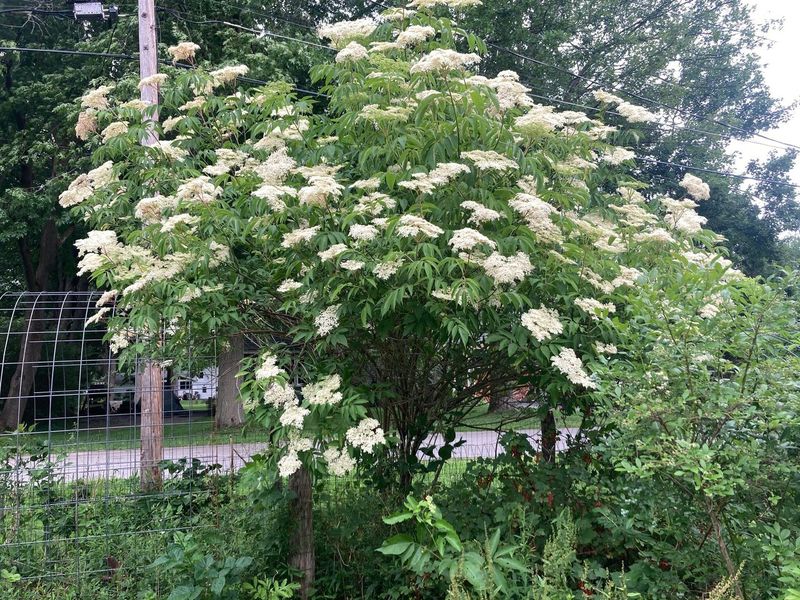
I think native bushes (aka shrubs) are the most underrated of landscaping possibilities. Because of their size, they are relatively easy to handle for planting

The 100-year-old maple that once stood in my front yard had to be removed recently. It just hurts my heart to think about it, but

THURSDAY MARCH 13, 2025 11 am: It’s a Jungle Out There–Floral Design— Dorothy Julius, Along Gardens Path Noon: Revisiting the Greats … Perennial Plant of

Looking for a new spring carrot recipe? Look no further! Our brown sugar and bourbon glazed carrots are a perfect side dish for early spring.

Want to garden comfortably? This padded bucket seat serves double duty as tool storage and a seat for gardening. We used materials we had on

As the days get longer and the temperatures begin to increase, our resident birds who stayed all winter will start to fill the air with
